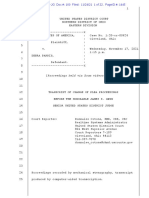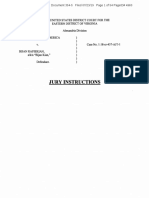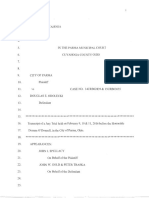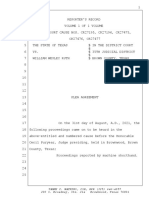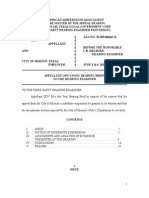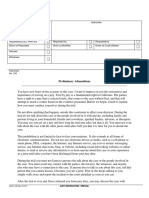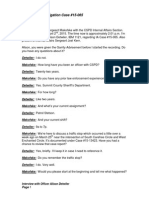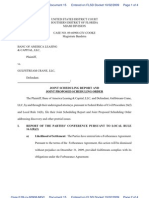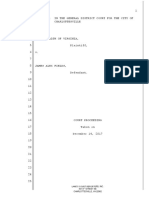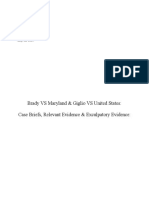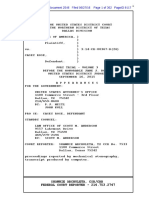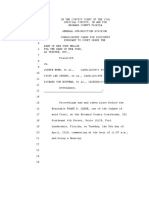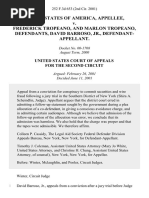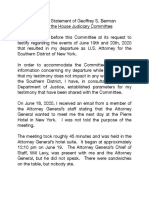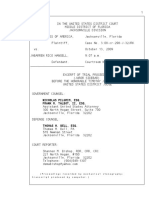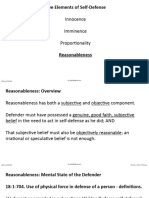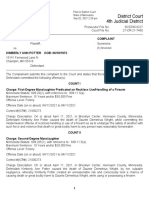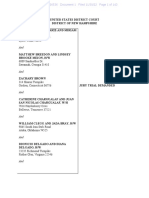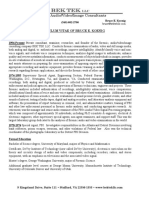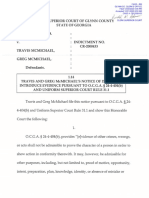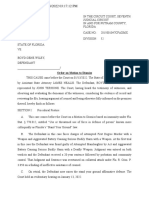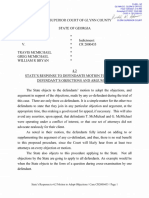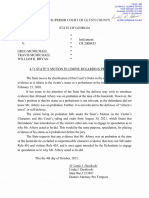100% found this document useful (2 votes)
703 views113 pagesDames Immunity Hearing Transcript
Dames Immunity Hearing Transcript
Uploaded by
Law of Self DefenseCopyright
© © All Rights Reserved
We take content rights seriously. If you suspect this is your content, claim it here.
Available Formats
Download as PDF or read online on Scribd
100% found this document useful (2 votes)
703 views113 pagesDames Immunity Hearing Transcript
Dames Immunity Hearing Transcript
Uploaded by
Law of Self DefenseCopyright
© © All Rights Reserved
We take content rights seriously. If you suspect this is your content, claim it here.
Available Formats
Download as PDF or read online on Scribd
/ 113
Filing # 115929056 E-Filed 10/30/2020 04:29:11 PM
IN THE CIRCUIT COURT OF THI
NINETEENTH JUDICIAL CIRCUIT
IN AND FOR ST. LUCIE COUNTY, FLORIDA
STATE OF FLORIDA
Case No. 56-2018-CF-003013-A,
Jason Lamar Dames
Defendant
NOTICE OF FILING
COMES NOW the State of Florida, by and through the Assigned Assistant State Attomey
and hereby files this Notice of Filing,
CERTIFIED TRANSCRIPTION OF STAND YOUR GROUND HEARING
1 HEREBY CERTIFY that a true copy of the foregoing has been furnished to, Mary
Celidonio, by eservice/email at the designated email address of Mary.Celidonio@pd19.org,
Gabrielle Rothman@pd19.org on October 30, 2020.
RESPECTFULLY SUBMITTED
BRUCE H. COLTON, State Attomey
By: /s/ William C, Long
William C. Long,
Assistant State Attorney
FL Barf: 60012
411 S. 2nd Street
Fort Pierce, FL 34950
(772) 465-3000
Designated eService address
SA19eService@saol9.org
Bon
Ca aan
10
1
12
1B
4
45
16
7
18.
19
20
2
22
24
25
IN THE CIRCUTT COURT OF
THE NINETEENTH JUDICIAL
CIRCUIT IN AND FOR ST.
LUCIE COUNTY, FLORIDA
STATE OF FLORIDA, CASE NO. 562018CF003013
Plaintiff,
JASON LAMAR DAMES,
Defendant.
TRANSCRIPT OF HEARING
This cause came before the Court for a hearing on the
Defendant's Motion for Declaration of Immunity and
Dismissal held on September 14, 2020, before the Honorable
William Roby, Circuit Court Judge, at the St. Imcie County
Courthouse, Ft. Pierce, Florida.
APPEARANCES :
For the State: For the Defendant (5):
William C. Long, Esquire Adam D. Less, Esquire
Office of the State Attorney 900 SE Federal Hwy, #100
Ft. Pierce, FL 34950 Stuart, FL 34994
wn
Caw an
10
1
12
B
4
15
16
7
18,
19
20
2
22
23
24
25,
INDEX
OPENING STATEMENT: Page
Mr. Long, on behalf of the State 7
Mr. Less, on behalf of the Defense 7
WITNESSES FOR THE Direct Cross = Redirect — Recross
srat
Officer Smith 9 45 74
WITNESSES FOR THE Direct Cross = Redirect — Recross
DEFENSE
Dr. Mark Rubino 18 84
STATE EXHIBITS Page
1A ~ Video (High Quality) 15 & 36
1B - Video (Enhanced/Zoomed In) 15 & 36
2 - Defendant's Interview on Thumb Drive 36
3 - Transcript of Defendant’s Interview 39
DEFENSE EXHIBIT: Page
1 - Dr. Rubino’s cv 80
2 - Defendant’s Medical Records 8
ARGUMENT :
Mr. Long
Mr. Less
cea aueurn
10
u
12
B
4
15
16
7
18,
19
20
21
22
23
24
25
THE BAILIFF: Your Honor, they’re all family
(indiscernible) .
THE COURT: Sure, if (indiscernible) do that.
THE BAILIFF: You mentioned earlier, you guys are
all family, right?
FEMALJ
Yes.
THE BAILIFF: All right. You all can slide down,
all the way down.
All right. Thank you.
THE COURT: Okay, well there’s nobody in my
waiting room.
MR. LONG: Judge, I think this is a rarity for
you. We have everyone here.
THE COURT: Everybody here? Okay. 1/11 have the
Zoom meeting on just in case.
Okay, we’re here on case number 2018CF3013, State
of Florida versus Jason Dames. Mr. Dames is present. Good
afternoon, sir.
THE DEFENDANT: Yes sir.
THE COURT: Mr. Less is here on behalf on Mr.
Dames. I’ve got the State of Florida represented by Mr.
Long. And with him is Officer -
OFFICER SMITH: Officer Smith.
THE COURT: -- Smith? Okay.
So this is your motion, Mr. Less. You have the
Ce aan eun
10
u
12
B
4
15
16
7
18
19
20
21
22
4
25
burden, right?
MR. LESS: No, Your Honor. By establishing prima
facie case it actually shows the burden to the State under
the stand your ground laws.
THE COURT: Okay.
MR. LONG: And, Judge, just by way of refresher,
THE COURT: That was the change in the statute.
MR. I
Yes, Your Honor.
MR. LONG: TI wasn’t gonna say it was an old for
you, but it is a new standard since you have come back to
the felony bench.
THE COURT: Yes.
MR. LESS: Yes.
THE COURT: I remember that. Okay.
So the State’s got to prove by clear and
convincing evidence -~
MR. LESS: Yes, Your Honor.
THE COURT: -- that either the high probable -
probability or likelihood of conviction.
MR. LONG: No.
MR. LESS: No.
MR. LONG: Essentially I have to disprove that he
was validly defending himself.
THE COURT: Got it. Okay. You got me some case
Ce aan eon
10
12
B
14
15
16
7
18.
19
20
2
22
23
24
2:
law. Is this the case law since the statute’s been
changed?
MR. LONG: A little of both and 1/11 go through
it with you, So, since the statute’s been changed, what T
did is I’ve laid out in the case law the current status of
burden, and that’s in some of the case law I’m gonna
reference.
THE COURT: Okay.
MR. LONG: But those opinions also the older
opinions are still reliable for their evaluation and fact
patterns.
THE COURT: Okay.
MR. LONG: But it’s just you have to interpret
them through the lens of the change in the case law
THE COURT: Okay ‘cause I’ve had six or --
MR, LESS: And, Your Honor, T actually ~
THE COURT: -- I've had six or eight stand your
ground hearings prior to the statute being changed
MR. LONG: So the analysis is very similar. It’s
just the --
THE COURT: Okay.
MR. LONG: -- (indiscernible) now on the State as
opposed to on the Defendant.
THE COURT: All right. Did you wanna give me
preliminary openings or waive them or what do you want to
cma ann ewn
10
12
1B
14
15
16
7
18,
19
20
21
22
23
24
25
MR. LONG: I’m sorry?
THE COURT: Did you wanna give me like a
preliminary opening or waive it or?
MR. LONG: Judge, I will give you a very brief
preliminary opening.
THE COURT: Okay.
MR. LONG: dust by way of laying a clean record
I/11 adopt the motion filed by the Defense as a prima facie
-- I/1l adopt the motion filed the Defense as a prima facie
evidence sufficient for the State to have to respond to
that immunity motion.
THE COURT: Okay.
MR. LONG: ‘There is some question about whether
or not the actual statute, the change in the statute is
retroactive. This offense actually occurred prior to the
change in the law, That said, in an abundance of caution
the State is operating as if it is retroactive. It’s an
unsettled matter before the Supreme Court right now.
THE COURT: Okay.
MR. LONG: On appeal what that would mean is
essentially you're holding this -- let’s just say the
legislature or the State or the Supreme Court rather
eventually comes back and says this was retroactive
there’s no prejudice to the Defendant ‘cause you've held me
Cen ane
10
il
12
B
14
15
16
7
18
19
20
21
22
23
24
25
to the burden as opposed to him to the burden. So in an
abundance of caution, based on the date of this offense,
I’m asking you to keep the burden on the State.
As far as a basic synopsis of the facts, I’m not
gonna go into great depth. I'll suffice to say that the
actual incident was captured on video. You're gonna see
that video. You will have the opportunity to make the
evaluation and determination for yourself. And we're gonna
go through that at some length. ‘The one caveat to all of
that that I would say is that it was a very fast video that
bears looking at -- I know you’re a football guy -- it’s
kind of like instant replay. It bears looking at very
closely. So with that I11 turn -- I don’t know if Mr
Less is doing any type of opening. I’m not gonna go beyond
that.
THE COURT: Yes sir
I read your motion.
MR. LESS: Yes, Your Honor. I think Mr. Long
actually touched on it. This video is gonna be a lot of
Monday morning quarterbacking with a lot of stopping. So I
think interpretation of the video is gonna say everything
that we need in this case.
THE COURT: Okay. Thanks.
Mr. Long, whenever you're ready
MR. LONG: Yes. With that note I would call
Cm aa we een
10
u
12
B
4
15
16
7
18,
19
20
2
22
24
25
Officer Smith.
THE COURT: Okay. You can raise your -~ if you
can come to the witness stand, that’d be great.
OFFICER CLERMISE SMITH, STATE WITNESS 1, SWORN
MR. LONG: Judge, may I inquire from the table?
THE COURT: Sure. Just make sure you use that
microphone.
MR. LONG: Certainly.
THE COURT: Okay, ma’am, I’m gonna have to ask
you to, if you don’t mind, pulling that mask down so we can
hear you? ‘Cause I’ve gotta maintain a record. ‘hanks.
Appreciate that.
OFFICER SMITH: You’ re welcome.
THE COURT: And we’ll social distance. Thanks.
Whenever you're ready, sir?
MR. LONG: May I proceed? Thank you, Judge.
THE COURT: Yes sir.
Just before you go, please state your full name
for the record, ma'am, and spell it.
OFFICER SMITH: My name is Clermise Smith.
‘THE COUR’
Spell it.
OFFICER SMITH: And it’s C-L-E-R-M-I-S-E, last
name is Smith, $-M-I-T-H.
THE COURT: Thank you, ma/am.
Whenever you're ready, sir?
Ce aa we ww
10
1
12
B
4
15
16
7
18
19
20
2
22
24
25
MR. LONG: Thank you, Judge.
DIRECT EXAMINATION
BY MR. LON
Q. Officer Smith, I see you’re in uniform. Where do
you work?
A. I work for the Fort Pierce Police Department
Q. How long have you worked there?
A. I've been working there for a little over five and
a half years.
Q. And in your time with the City of Fort Pierce what
have your various job descriptions been?
A. Road patrol. I worked in the detective bureau.
And now I am the recruiter and background investigator.
THE COURT: You're a what? And now you're what?
OFFICER SMITH: The recruiter and background
investigator.
THE COURT: Recruiter. Okay. Thank you.
BY MR. LONG:
Q. And in September of 2018 what was your job
description?
A. I was working in the detective bureau as a
detective.
Q. How long had you been in that role?
A. Two years.
Q. As a detective or as an officer at that point?
cea annueen
10
1
12
1B
4
13
16
7
18,
19
20
2
22
23
24
25
10
A. As a detective.
Q. Okay.
So, you're working as a detective in September of
2018. Tet me just ask, and T know that Judge Roby is aware
of this but we need to lay a clean record, what was your
job description at that point in time?
A. Job description?
Q. As a detective.
A. As a detective my job description was to
interview, interrogate, as well as review cases and --
Q. And I take it you handled matters from a homicide
on down to the mundane?
A. Yes.
Q. Okay.
I mentioned earlier the date September 1:t of 2018. on
that date did you have the opportunity to begin incident or
rather an investigation into an incident that occurred at
what is commonly known as the Rice Hut?
A. Yes, that is correct
Q. Okay.
And what -- well first, where is the Rice Hut?
A. The Rice Hut is located on the corner of 25t
Street and Avenue D in Fort Pierce.
Q. Okay.
Now, with regards to this location, were you aware of
cma anneurn
10
1
12
1B
4
15
16
7
18
19
20
2
22
23
24
25
1
that location previously through your time in law
enforcement?
A. Yes, I was aware.
Q. And have you ever responded to other crimes at
that location?
A. T do not recall
Q. All right.
Would it be fair to say that that location is of a
nature that pole cams have been employed to monitor the
area?
A. Yes it is.
Q. So you responded to that location on September the
1st, 2018, What time did you arrive?
A. I'm gonna refer to my report just to make sure
that it’s accurate time.
Q. Well I/11 just -- I/11 put it to you this way
How did you proceed with your investigation?
A, I was contacted by my sergeant in reference to a
shooting that occurred at the Rice Hut. I ended up going
to the scene in reference to the shooting to start my
investigation.
Q. Now were you the only officer who was on scene?
A. No.
Q. Were you what's called the lead case agent?
A. Yes.
Cerra een
10
12
1B
14
15
16
7
18,
19
20
21
22
24
25
12
Q. What does that mean?
A. The lead detective is the one that the primary
officer would provide the information pertaining to the
incident, and then I would follow up with the investigation
until I see it to the end.
Q. Would it be fair to say that other members of law
enforcement within your agency were essentially working for
you as you investigated the case?
A. Yes, that is correct.
Q. And through those other officers did you learn
information about the case?
A. Yes I did.
Q. While you were on scene are you aware of the
nature of the crime that was called in that ultimately
caused Fort Pierce to respond?
A. Yes T was.
Q. What had happened?
A. I was called to the Rice Hut in reference to two
males having an altercation. And then the Defendant ended
up shooting the victim, as well as another male that was in
the middle of them.
MR. LESS: Objection, Your Honor. That’s a
misstatement of facts. There was only one person shot
THE COURT: That’s her testimony. Objection
overruled.
Cea auewrn
10
12
13
4
1S
16
ae
18
19
20
21
2
23
4
25
1B
BY MR. LONG:
Q. We'll go through the specifics of ultimately a
video --
THE COURT: You can bring that out in cross T
guess. Thanks.
BY MR. LONG:
©. And we'll look to the specifies of video. And I’m
kind of trying to give the Judge a forest (indiscernible)
So just with regards to your initial investigation, would
it be fair to say that you responded to the scene for a
homicide?
A, That is correct.
Q. All right.
Now, were you present when the actual events of the
homicide occurred?
A. Actually, correction, it was for a GSW.
Q. Gunshot wound?
A. Correct.
Q. Okay. GSW is a common law enforcement acronym for
gunshot wound?
A. Yes. Correct.
Q. So you respond to the scene for a gunshot wound.
A. Yes.
Q. When you arrive you said you began your
investigation. Was one of those investigative steps to
cma ane wn
10
1
12
1B
4
13
16
7
18
19
20
2
22
23
24
25
14
acquire the surveillance which we previously talked about?
A. Yes.
Q. And how did you acquire that?
A. I got the recording from the Rice Hut, as well as
other detectives collected the -- I mean, other officers
also collected the video
Q. Okay.
And to the -- and I anticipate the Defense stipulating
to the admission of the video, but to the best that you can
recall, have you reviewed the video at issue in this case?
A. Yes I have.
Q. Does it fairly and accurately depict the video as
you collected it on the date in question?
A. Yes it does.
Q. Now you again weren’t actually there when the
shooting occurred, correct?
A. Correct.
Q. Your investigation is one hundred percent after
the fact?
A. That is correct.
MR. LONG: Judge, this -- what I intend to offer
into evidence, and I’ve spoken with Mr. Less, I don’t
anticipate an objection, State’s Exhibit 1 is a two-fold
exhibit. It contains the same image. One is more zoomed
in than the other. State's Exhibit 1 is the actual video
Cea aue
10
1
12
1B
14
15
16
7
18
19
20
2
22
23
24
25
15
of the incident that Officer Smith was just describing.
State’s Exhibit 1B, if you will, is the zoomed in view. At
this time --
THE COURT: Enhanced?
MR. LONG: I’m sorry?
THE COURT: It’s enhanced?
MR. LONG: It’s only enhanced in so much that
it’s a screen capture of a specific location of the first
(indiscernible) recording.
THE COURT: Any objection?
MR. LESS: We did not obtain the enhanced version
during discovery. I would like to review it real quick
before it is objected or not objected to.
THE COURT: Okay.
MR. LESS: No objection, Your Honor
THE COURT: Okay.
(State's Exhibit 1 received in evidence.)
THE COURT: Whenever you're ready?
MR. LONG: ‘hank you, Judge. I just need to a
lay a little bit of ground work first.
BY MR. LON
Q. So, Officer Smith, I know you collected the video
at the scene that’s now in evidence. We’re gonna look at
that here in a moment. When you collected the video were
you also present as the scene itself was processed?
Cerrar wn
10
1
12
1B
4
13
16
7
18
19
20
2
22
24
25
16
A. No.
Q. And as your role as the lead case agent, are you
aware whether or not evidence was collected from the scene?
A. Yes T was aware that evidence was collected from
the scene.
Q. Specific to shell casings, shell casings being
spent rounds of ammunition, are you aware if any spent
rounds of ammunition or shell casings were located on the
scene?
A. Yes.
Q. How many were located?
A. Three.
Q. Did you personally collect those?
A. I did not.
Q. But you're aware that they exist and were
collected?
A. That is correct.
Q. All right, at this time -- can you
okay or do you need me to turn it
A. If you could turn it a little bit? There’s glare
Q. Is this any better?
MR. LONG: Defense, can you still see the screen?
MR. LESS: Yeah, I can (indiscernible)
THE COURT: You can come over here if you want
(State Exhibit #1 published to the Court)
Cerra aneern
10
1
12
B
14
15
16
7
18,
19
20
2
22
23
24
25
7
BY MR. LONG:
Q. All right. Officer smith, before we work through
the video, if you could, just orient for Judge Roby. And I
will ask you to assume he doesn’t know anything about this
location. So just orient for Judge Roby what he’s
ultimately looking at.
A. Okay. Where that white truck is, that would be
heading in the direction of south.
0. Actually, Officer Smith, would you mind stepping
down?
A. Yes.
THE COURT: You can put your mask on if you want.
You don’t have to. It’s up to you.
MR. LONG: I’m not worried about Officer Smith.
THE COURT: Okay. Okay. ‘Thanks
BY MR. LONG:
Q. So without blocking the screen, when you reference
the white truck if you could just reach out and point at it
so Judge Roby knows what you're talking about?
A. This white truck is heading southbound on 25¢
Street.
Q. And we (indiscernible) talked about an area called
the Rice Hut. Where is that location?
A. The Rice Hut is this building right here
Q. Now, what I would like to do is to have you
Cera an ewrn
10
12
13
4
1S
16
7
18
=
20
21
23
4
25
18,
identify known individuals in the video that are pertinent
to your ultimate investigation in this case. Could you
show Judge Roby where the Defendant is located at the
beginning of this video?
A. The Defendant is standing right here in the dark
colored clothing.
THE COURT: Yeah, I can’t even -~ you might as
well not even show that. T can’t see anything
MR. LONG: I can move it closer, Judge
THE COURT: 1 mean, okay.
MR. LONG: Judge, once people begin moving you're
gonna be able to see things much --
THE COURT: Okay.
MR. LONG: You know, and if you can’t I/11 move
it closer for you.
THE COURT: You can give me a copy of it to take
in chambers, right?
MR, LONG: Certainly, Judge.
THE COURT: Thanks.
BY MR. LONG:
Q. Standing next to the Defendant is there anyone
present?
A. Yes.
Q. Now, that person albeit is difficult to see,
correct?
Bowe
cx a any
10
1
12
1B
4
13
16
7
18
19
20
2
23
4
25
19
A. Correct.
Q. But is that individual in all white clothing?
A. Light colored clothing, yes.
Q. Light colored. And where is that individual --
THE COURT: Hold that thought. We moved all
these folks way over there in the corner and T don’t know
if they can see this either, so you wanna move them back
together so they can see the video?
You all wanna see the video too, right?
Okay, let’s move them back over here ‘cause they
can’t see squat. ‘Thanks.
THE BAILIFF: Well I am gonna request that
everybody move to the third row, please.
THE COURT: Can you all see the screen at all?
MR. LONG: Judge, for officer safety T will
advise that’s the victim's family seated behind the
Defendant.
THE COURT: Okay. Thanks.
BY MR. LON!
Q. All right, Officer Smith, we were working through
this. So, in front of the Rice Hut we have two individuals
of interest, correct?
A. Correct.
Q. And you said the second one is in light colored
clothing. ‘Through your investigation were you able to
bk wD
RO cet lay
10
il
12
1B
4
15
16
17
18,
19
20
21
22
23
24
25
20
determine who that person was?
A. Yes, Marcus.
Q. Marcus. Now does Marcus have a first name, last
name?
A. I do not remember the last name.
Q. All right.
And who is that person in relation to the Defendant?
A. The Defendant stated that was his cousin.
THE COURT: Hold on. Hold that thought. Can we
get her a microphone? A handheld mic. ‘Thanks
Okay, go ahead. thanks.
MR. LONG: Thank you, Judge. And if T need to
speak up just let me know.
THE COURT: You have no problem
OFFICER SMITH: I’m soft spoken.
THE COURT: Okay. ‘That’s why I got the mic.
BY MR. LONG:
Q. So, we have two individuals in front of the Rice
Hut location. We’ve identified the direction. Now, within
this image is the victim located in any location?
A. No.
Q. All right.
Well, are you aware of where the victim is within this
frame?
A. The vehicle heading west.
Cea au een
10
1
12
1B
14
15
16
7
18,
19
20
2
22
23
24
25
2
Q. All right, would that be the vehicle I’m pointing
at here?
A. Yes.
Q. Okay.
MR. LONG: All right, Judge, what I would ask
permission from the Court to do, I’m gonna play the video
once in its entirety and then work back through it, unless
there’s an objection from the Defense.
THE COURT: Sure.
MR. LESS: ‘There’s no objection.
BY MR. LONG:
Q. All right, Officer Smith, we’re gonna watch the
zoomed in view next and kind of go through things. But as
we -- kind of set the scene for Judge Roby in this.
Obviously towards the tail end of the video we see multiple
units responding. Were you any of those units?
A. No.
Q. Ultimately as you begin to conduct your
investigation were you able to kind of piece together what
had happened here?
A. After hearing what the primary officer provided
me.
Q. And we saw the Defendant after he shot remaining
on the scene. Was he on scene until he was taken into
custody by law enforcement?
Cm aa we wn
10
1
12
B
4
15
16
7
18
19
20
2
22
23
24
25
Q
A
Q
22
Yes.
Where was the firearm in question?
On the ground.
Did he essentially remain there and wait for law
enforcement to get there?
A
Q
any way,
A
Q
Yes he did.
When he got there did he resist law enforcement in
shape, or form?
No he did not.
And ultimately -- and we’ll get to this later, but
ultimately did you conduct an interview where he spoke with
you about the incident?
A
Q
Yes he did.
So going back to the more zoomed in view,
THE COURT: Are we anticipating anybody
testifying from the St. Lucie County Jail?
MR. LESS: No, Your Honor. I think they still
have that on there from Mr. Dames.
THE COURT: Okay.
MR. LESS: ‘Cause we had that issue with
transport.
THE COURT: I am turning off the Zoom. There's
nobody there except for the St. Lucie County Jail and it’s
an empty room. Thanks.
Okay. Go ahead.
Cm a ae een
10
il
12
13
14
1S
16
7
18
19
20
21
22
23
24
25
23
BY MR. LONG:
Q. Now, this image was not created by the Fort Pierce
Police, correct?
A. Correct.
Q. In fact I showed it to you today and it’s just a
screen capture of the same image, correct?
A. That is correct.
Q. All right.
But setting the stage for Judge Roby, and just for the
record this is now the second portion of State's Exhibit 1,
the zoomed in view and it’s labeled that as such under the
file name, if you could again set the stage just for the
location for Judge Roby as to where the Defendant is
currently located.
A, The Defendant is standing in the dark colored
clothing. Sorry.
Q. That's okay.
And as far as the other individual, again it's
difficult to see, but if you could identify for Judge Roby
where the other individual is?
A. Hefs standing to the left of the yellow door.
Q. And in the grand scheme of things this whole
incident took, what, approximately 20 seconds?
A. Approximately.
Q. What I'd like to do is walk through and we're
Cea awe wn
10
1
12
B
14
15
16
7
18,
19
20
21
22
23
24
25
24
gonna label specific times within this recording. For the
record and for appellate purposes, again part B of State’s
1. The video begins at 0-00-00 seconds. Moving forward in
time to -- one moment -- 00-42 seconds, at this point in
time has a vehicle arrived on the scene?
A. Yes it has.
Q. Through your investigation were you able to
determine who this person exiting the vehicle at 42 seconds
is?
A, That is the victim, Jackie McMiller.
Q. Okay.
In your investigation were you able to determine was
the victim a large man, small man?
A. He was a large man.
Q. Do you have -- are you aware of what his physical
description would be as far as height and weight?
A. Approximately 672” or 3”, over 250 pounds
Q. Would it be fair to say that he was larger than
the Defendant?
A. That is correct.
Q. And then what is the -- what are the Defendant’s
physical description at this point in time?
A. Approximately over 250 pounds and approximately
61", 672”.
Q. Now there was a third individual, an individual in
25
25
white clothing. In terms of his size, how did he compare
to the other two?
A. He was smaller.
Q. On arrival was it apparent or did you learn
through your investigation that there was some animus
between the victim and the Defendant?
A. Yes.
Q. And what was the nature of that animus, of that
disagreement?
A. It was over a female.
MR. LONG: I’m just gonna let this play for a
second.
BY MR, LONG:
Q. At approximately 48 seconds we see the victim take
some action towards the Defendant. Now, can you tell Judge
Roby today what was in any of these individual’s minds?
A. No.
Q. To do so --
THE COURT: When you say “take some action”, it
looked like he punched him in the face.
MR. LONG: ‘hat’s exactly what I’m getting at.
Judge.
THE COURT: Okay. ‘The victim punching --
MR. LONG: Correct.
THE COURT: -- Mr. Dames in the face.
24
25
26
MR. LONG: Correct.
BY MR. LONG:
Q. Would it be a -- would I be putting words in your
mouth to say that it is apparent that the victim was the
primary aggressor initially on scene?
A. That is correct.
Q. Okay.
And just so it’s clear for (indiscernible), the victim
was aggressive towards the Defendant.
Okay, at 56 seconds an initial skirmish has occurred
between the two individuals, the Defendant and the victim
is that fair to say?
A, That is correct.
Q. Now, at 57 seconds, for Judge Roby’s edification
through your investigation were you able to identify who
this person on the left is?
A. That is the Defendant.
Q. And who is the person on the right?
A. The victim.
Q. Is there an individual standing between them?
A. Yes.
Q. Now, I asked you before whether or not any shell
casings were located on scene and you indicated three, is
that correct?
A, That is correct.
Ce aan een
1
12
1B
14
13
16
7
18
19
20
2
22
23
24
25
27
Q. As part of your investigation did you attend the
autopsy in this case?
A. Yes T did.
Q. And where did that autopsy occur?
A. At the Medical Examiner's Office at Indian River
State College.
Q. Now, are you a physician?
A. I am not.
©. Can you tell Judge Roby anything from a medical
perspective?
A. I cannot.
Q. But you were physically present at the autopsy
correct?
A. That is correct.
Q. At the autopsy did you observe any bullet holes in
the body of the deceased?
A. Yes I did.
Q. And if you need to refer to your notes you
certainly can. Do you recall where the location on the
victim's body those bullet holes wore?
A. Yes.
Q. Where were they?
A. Chest/abdomen, hip, and lower back
Q. Now when you say chest/abdomen, is that kind of a
general that one --
Caer aneen
10
1
12
B
14
13
16
7
18.
19
20
2
22
23
24
25
28
A. Like a general area, one.
Q. Okay.
So, the first one was in the chest/abdomen area
Where's the second one?
A. ‘The second one is in the hip area.
Q. And where's the third one?
A. And the third one is in the back.
Q. All right.
So, through your investigation we know the victim was
shot three times and we know that there are three shell
casings located on the scene, is that correct?
A. Correct
0. As you stand here today can you tell Judge Roby
which one came first as far as orientation on the body?
A. The chest and abdomen.
Q. And what is your basis for that?
A. Because the victim was facing the suspect.
Q. Okay.
Now, at 59 seconds within this video can you please
identify again for Judge Roby who the individuals are and
where they're located?
A, The Defendant is here. His cousin is in between
them in the white. And that’s the victim.
Q. Now you have been to the Rice Hut location,
correct?
Can aba wn
10
1
12
3
14
15
16
v7
18,
19
20
21
23
24
25
29
A. Correct.
Q. I'm not asking you to get a measuring tape. I’m
not asking you to tell me exactly. But can you tell Judge
Roby approximately how much distance is now separating the
victim and the Defendant?
A. Approximately six feet
Q. And through your investigation were you able to
determine whether or not the victim had any firearm or
weapon on him at this point in time?
A. I did not know at that time if the victim had a
weapon.
Q. Do you know now?
A. I do know now.
Q. And what is the answer to that question?
A. He did not have a weapon.
Q. Okay.
Is this moment in time that we’re paused at, at 59
seconds, is this almost immediately prior to the shooting?
A. Yes.
©. And as the shooting is unfolding is there anything
of investigative note about the manner in which the victim
is standing?
A. The victim is actually, if you can see the leg is
turned, the right leg is turned
Q. Okay.
bok ow
eo a Ow
10
TT
12
14
15
16
7
18,
19
20
21
2
23
24
25
30
And why is that significant to you?
A. Because he’s on his heel and he’s not progressing
towards the Defendant but appears to be retreating
Q. And is there anything of investigative note with
regards to the Defendant’s mannerisms?
A, ‘The Defendant looks as if he’s pushing past the
cousin that’s in between them with his arm out with the
weapon.
Q. And through your investigation were you able to
determine whether or not the Defendant was in possession of
a firearm?
A. Yes.
©. Was that a lawfully carried firearm?
A. Tt was.
Q. In fact, he had a valid concealed weapons permit
correct?
A. That is correct.
Q. Okay.
At the time this shooting occurred, as they are
separated here, is there anything of note with regards to
the Defendant's body posture that you take note of as in
part of your investigation?
A. Yes, that he’s progressing towards the victim and
pushing his cousin out of his way.
Q. Now, you and I have watched this video many times.
Caer ane wn
10
12
1
4
15
16
7
18,
19
20
21
22
23
24
25
3
You've probably watched it far more than I. You mentioned
three shots being fired. Can you see all three shots in
terms of muzzle flash on this video?
A. I cannot.
Q. Okay.
MR. LONG: Resuming play at 59 seconds, for the
record.
BY MR. LON
Q. By 1 minute and 2 seconds we now know based on the
physical evidence that was collected on the scene that
we've had three rounds discharged, correct?
A. Correct.
Q. And this is as the Defendant pushes through his
cousin to get to the victim?
A, That is correct.
©. Is there any dispute from law enforcement the
victim initially responded on scene and was clearly the
primary aggressor?
A. State that again.
Q. Is there any disputing the fact that -- I mean,
from the video you can see the victim come into this area
park. Clearly hits the Defendant first. Is that all
correct?
A. That is correct.
Q. Okay.
bk we
Cora
10
TT
12
1B
14
15
16
7
18,
19
20
21
22
23
24
25
32
If Mr. Less stands here and cross examine you, which I
anticipate he’ll do, can you say anything with regards to
the mindset of these individuals involved?
A. I cannot.
Q. Okay.
Now, after the victim -- or the victim goes down, you
indicated you went to the autopsy, how did your
investigation proceed with regards to the Defendant
himself?
A. The Defendant was detained and transported to the
detective bureau where 1 met him and interviewed him in the
interview room.
Q. Were you ever able to locate this individual?
A. Yes I was.
Q. And by that individual, who is that?
A. Marcus.
Q. All right.
And you can go ahead and have a seat. If you wanna
look to your notes, looking at the report you completed in
this case refresh your recollection as to Marcus’ identity?
A. Marcus Ferguson.
Q. ALL right.
And the notes that you're looking at, and again this
is just for appellate purposes, were those reports,
supplements, affidavits you completed in conjunction with
ea Ahk wD
10
1
12
1B
“4
15
16
7
18
19
20
2
22
23
4
25
33
your initial investigation in this case?
A. The supplement for Marcus Ferguson's interview was
conducted by Detective Quinteo [phonetic].
Q. Okay, but looking at it, it was an investigation
that ultimately you as the lead case agent compiled
initially in this case. Would that be fair to say?
A. That is correct.
Q. And looking at it today did it help refresh your
recollection?
A. It would, yes.
Q. It did. Okay.
A. It doo:
Q. All right.
You can stay seated. I apologize, I did skip forward
on one point. At any point in time during the shooting are
you able to see at least one muzzle flash?
A. Yes
Q. Okay.
What I’m gonna do is I’m just gonna let it play. If
you could identify for Judge Roby when you see that flash?
A. Now.
Q. At the time that you saw the muzzle flash is there
anything of significance as far as the behavior of the
victim?
A. hands are down by his side.
wn
Cena
34
Q. Was the victim approaching the Defendant
A. No.
Q. In fact what was the victim doing?
A. Turning
Q. All right.
Now you indicated before that you were able to
determine the initial shot went to his chest and abdomen
Were you able through your investigation to determine where
the remaining shots went?
A. Towards the hip and then the back.
Q. And ultimately how would you describe the action
the victim is taking as the Defendant progresses on him?
A. Hels retreating.
Q. And -~
A. As he’s turning.
THE COURT: Well, ma'am, he’s retreating because
he notices that the Defendant has a gun. Isn’t that why
he’s retreating?
OFFICER SMITH: That is correct.
THE COURT: It looks -- okay.
BY MR. LONG:
Q. So the victim is fleeing the firearm which the
Defendant is displaying as he’s approaching him, correct?
A. Correct.
Q. And this is after having pushed through his cousin
Cea ane en
1
12
1B
14
15
16
7
18
19
20
2
22
23
24
25
35
to be able to take action against the victim, is that
correct?
A. That
Q. Now
is correct.
you indicated that part of your investigation
involved an interview of the Defendant, correct?
A. Yes.
Q. Now
where did that occur?
A. It occurred at 920 South US Highway 1 at the Fort
Pierce Police Department
Q. And
who conducted that interview?
A. I conducted the interview.
Q. Have you had the opportunity, what ultimately will
be marked as
it’s a thumb
A. Yes.
Q. And
State’s Exhibit 2 for identification purposes,
drive with your initials on it.
when did you review this?
A. Today.
Q. In listening to it did you recognize your voice?
A. Yes
Q. Did
A. Yes
I did
you recognize the Defendant’s voice?
I did.
Q. Is it in fact a recording of the interview you
conducted of
A. That
Q. And
the Defendant?
is correct.
when did that interview occur?
Ce aan ek en
10
12
13
“4
15
16
WW
18
19
20
2
2
2
24
2
36
A. That occurred on the night of the shooting.
Q. Does it fairly and accurately depict that
interview?
A. That is correct.
MR. LONG: Judge, at this time I would tender
what will ultimately identify as State’s Exhibit 2 into
evidence as State's Exhibit 2
THE COURT: Any legal obj
MR. LESS: No objection.
THE COURT: Without objection it will be
submitted into evidence as State’s Exhibit 2.
(State's Exhibit 2 received in evidence.)
MR. LONG: Judge, I don’t --
THE COURT: Are you seeking to introduce both
versions of the video?
MR, LONG: If I didn’t already, yes Judge, 1/11
seek to introduce that as well.
THE COURT: And there’s no objection?
MR. LESE
: No objection, Your Honor
THE COURT: Without objection -- it is gonna be
Composite Exhibit 1?
MR. LONG: State’s Composite 1, yes Judge.
THE COURT: State’s Composite 1 consisting of
both the regular view and the enhanced view.
(State's Exhibit 1A and 1B received in evidence. Was
37
also done previously on page 14.)
MR. LONG: Correct. And just for the record,
it’s two Windows media files. One is labeled “high
quality”. That’s the one that’s taken from some distance.
The second is labeled “zoom”. There’s no enhancement done
whatsoever. It’s literally just a screen capture
(indiscernible) .
THE COURT: I use the word enhanced because it's
made bigger.
MR. LONG: Correct. Well, it’s not cleaned up in
any way.
THE COURT: No. Enhancement doesn’t necessarily
mean cleaned up. It means it’s easier to see, so. That's
how I use the term enhanced.
MR. LONG: Understood, Judge. I’m not arguing
with you on the point.
THE COURT: That’s okay.
BY MR. LONG:
Q. So, you conduct your investigation. You interview
the Defendant. Ultimately what did the Defendant tell you
about the altercation and what had happened? And you can
summarize here. You don’t have to quote directly.
A. Okay. Well, the Defendant pretty much told me
that he had --
Q. It’s okay. You can go ahead.
Cerra aAneen
10
12
13
4
15
16
v7
18,
19
20
2
22
23
24
25
38
A. That he went somewhere with a friend and then he
was stranded once the friend went home. And he started
walking in the direction to go home because he didn’t have
a ride because his friend couldn’t take him back. And he
was walking around Fort Pierce trying to find a phone to
call for a ride. He ended up meeting his cousin, who!s
depicted in the white clothing, in front of White Diamond
where he attempted to use his cousin's phone.
Q. If I could just interject at one point. White
Diamond, Judge Roby may not be familiar with the area.
Could you just explain to him what that is?
A. White Diamond is a hair store off of Orange Avenue
sth Street.
and South
Q. Okay. I’m sorry, so from that point forward he
borrowed his cousin’s cell phone.
A. He didn’t use the phone at that time
Q. Okay. I’m sorry, go ahead. (Indiscernible)
A. And then he walked with his cousin north on South
25% Street, or North 25t Street till they got to Rice Hut
And then he asked his cousin to use the phone. At the time
they were standing there he saw the victim pull up. And
then the incident occurred, the shooting. He stated that
he took the gun apart after the incident occurred and
waited for law enforcement
MR. LONG: Judge, I actually have a transcript of
bk we
wma.
10
1
12
1B
4
15
16
7
18
19
20
2)
22
23
24
25
39
that interview. If I could -- and I have a copy for the
Defense as well. Would the Court have any objection to one
being attached at Court Exhibit 1?
THE COURT: Any objection?
MR. LESS: No objection, Your Honor.
THE COURT: Without objection it will be admitted
into evidence as Composite Exhibit State 3.
(state's Exhibit 3 received in evidence.)
MR. LONG: It could just be labeled as State’s 3
That’s fine, Judge. I apologize, the staple just fell out
on that as well. I don’t anticipate relying on that too
extensively, but I can tell Your Honor it’s easier to make
your way through the interview through the transcript and
listening.
THE COURT: Okay.
BY MR. LONG:
Q. So, in your -- I'm sorry, Officer Smith, getting
back to your work in this case. In your encounter with the
Defendant in the interview room at the Fort Pierce Police
Department the night that all this
ppened was there any
comment or discussion with regards to the idea of a
ventricular shunt?
A. Yes.
Q. Who brought that up?
A. The Defendant brought that up.
Ren
Cw aa
10
1
12
14
15
16
7
18,
19
20
21
23
24
25
40
Q. What did he tell you about a ventricular shunt?
A. He stated that he had a ventricular shunt in his
head which drains the fluid from his brain into his
stomach.
Q. And why was that -~ well, I711 put it to you this
way. Could you tell whether or not the Defendant believed
that point was important?
A. The Defendant believed that that point was
important.
Q. And did he tell you why he felt that way?
A. Because he felt that if he got hit in the shunt
then that could be life threatening.
Q. At the time —~
‘THE COUR’
Kind of like getting hit in the face?
Yes?
OFFICER SMITH: I’m sorry?
THE COURT: Kind of like the shot we saw where
the victim punched him viciously in the face? You saw
that, right?
OFFICER SMITH: Yes I did.
THE COURT: Unprovoked it looked. Didn’t seem to
be provoked.
OFFICER SMITH: Yes.
THE COURT: Came out of nowhere, didn’t it?
OFFICER SMITH: Yes it did.
Ce aan een
10
u
12
B
4
15
16
7
18
19
20
21
22
23
24
25
4
THE COURT: Okay.
MR. LONG: And that fact is not disputed by the
State.
THE COURT: Okay.
So this gentleman’s got a ventricular shunt in
his head and he gets viciously punched in the face out of
nowhere.
MR. LONG: Correct.
THE COURT: And he’s not supposed to -~ okay.
MR. LONG: Judge, I understand your initial
thoughts. I would ask for the opportunity to rely ~~
THE COURT: Sure.
MR. LONG: -- on the case law and argument.
THE COURT: Yeah, I’m not gonna -- I'm not gonna
make any decisions, but this ain’t my first rodeo. I
played four years of college football.
MR. LONG: Understood, Judge
THE COURT: I know what kind of shots people
take. And I may have gotten in a few fights in my lifetime
on the field too, so.
MR. LONG: And, Your Honor, I will reserve my
response to that when it comes time to argue.
THE COURT: Okay. All right.
MR. LONG: TI wouldn’t be standing here as the
State unless I thought I could win.
cea aueern
10
1
12
1B
4
15
16
17
18.
19
20
21
22
23
24
25
42
THE COURT: I got it. Keep going.
BY MR. LONG:
Q. So, Officer Smith, is there any evidence at the
time the Defendant pulled the trigger that he was actively
threatened by the victim?
A. No.
Q. In fact, there was separation between the two,
correct?
A. That is correct.
©. In fact, the Defendant had to push his way through
his cousin as the victim was backpedaling away from him
correct?
A. That is correct.
Q. Ultimately after you concluded your interview with
the Defendant on the night in question what action did you
take?
A. The Defendant was released and I continued with my
investigation to speak with the witnesses because I hadn’t
spoken to all of the witnesses at that time. And then T
continued on with following suit with a warrant.
Q. Okay.
As it pertains to the minutes in time, or rather
seconds in time before the trigger is pulled, after the
initial altercation when the victim respond -~ victim gets
on scene, do you know of any better evidence than the video
Cera anne en
10
ul
12
14
1
16
17
18,
19
20
2
23
24
25
43
itself?
A. No.
Q. Okay.
MR. LONG: Judge, if I could just have one
moment, please?
THE COURT: Sure.
BY MR. LONG:
Q. When you arrived on scene are you aware of whether
or not the victim was deceased on scene or whether he was
ultimately died at a hospital?
A. I responded to the hospital.
Q. Okay.
And was he declared dead at the hospital?
A. No.
Q. Where was he declared dead?
A. I'm sorry, he would have been declared at the
hospital, but it wasn’t at that time
Q. Okay.
When we began our question and answer here there was
initially an objection from the Defense regarding facts not
in evidence and a description of who was present in front
of the Rice Hut. T believe initially you may have put an
extra person there. Was that a mistake?
A. Can you restate that?
Q. When we -~ when you initially started describing
ee
woe
wma
10
1
12
B
14
15
16
7
18
19
20
2
22
23
24
25
44
what had happened in front of the Rice Hut I think you may
have accidentally described it being four people not three.
At any point in time did you intend to describe other than
what’s depicted in the image?
A. I said there was two males.
Q. Okay.
A. And then when I brought up the third individual T
was talking about the cousin.
Q. Okay.
A. So that’s three.
MR. LESS: Your Honor, if T may just clarify? My
objection was I believe the officer just misstated that he
-- when he fired was shooting at two individuals.
OFFICER SMITH: Oh. No, that’s not what I meant.
THE COURT:
Well that’s pretty clear that he
wasn’t firing at two individuals.
MR, LESS: Yes, At the time that’s (individual)
THE COURT: So I11 take judicial notice of the
fact that he was not firing at his cousin who was trying to
hold both him and at one point the victim back.
BY MR. LONG:
Q. All right, Officer Smith, T don’t have any other
questions for you at this point in time. T may later.
MR. LONG: Mr. Less, would you like me to leave
the screen up here for you?
woken
wana
10
aes
13
4
ube
16
17
18,
19
20
rat
22
_
24
25
43
MR. LESS: Yes, please.
MR. LONG: Which video would you like?
MR. LESS: Can you go back to the -~ to State's
1A?
CROSS EXAMINATION
BY MR. LESS:
Q. Officer Smith, you stated you were in the
detective bureau for two years at the time that you caught
this case?
A. At the time that I caught this case it was a
little over two months.
Q. Oh, a Little over two months?
A. Yes.
Q. How many shootings had you worked in that amount
of time?
A. T cannot recall
Q. Had you ever worked any murders?
A. I'm recalling my training because I assisted other
detectives on their cases during that time. So at this
present moment I cannot recall.
Q. Okay.
Had you completed your FTO before bec a
detective?
A. Yes I did.
Q. You did? Okay.
Cae uwaee un
10
1
12
1B
4
15
16
7
18,
19
20
2
22
23
24
25
46
And did you do any investigations that involved a
self-defense or stand your ground?
A. No I did not.
Q. When you initially interviewed Mr. Dames and he
told you that he had a ventricular shunt and that a hit
like this could cause death or serious injury did you
investigate what a ventricular shunt was?
A. Yes, I did look it up.
Q. So who did you speak with regarding what a
ventricular shunt is?
A. I used my training and experience with, you know
the internet that we use.
Q. So you Googled it?
A. And I also spoke to other detectives in reference
to that.
Q. Did you speak with a neurologist?
A. No I did not.
Q. Speak with a neurosurgeon?
A. No I did not.
Q. Any medical professional that could tell you
whether or not his fear was reasonable?
A. No I did not.
Q. So you testified -- you testified that it is
undisputed that the victim in this case was the primary
aggressor?
bk eo
waa )|
10
12
B
4
1
16
7
18
19
20
2
22
23
24
25
47
A. Correct.
Q. Okay.
When did that change in your mind?
A. At the time the victim was no longer progressing
towards the Defendant.
Q. Let me rephrase. When did -~ during the case's
progression, after Mr. Dames was arrested, when did you
change your mind that Mr. Dames was not the primary
aggressor?
A. Repeat the question.
Q. Isn't it true you initially arrested Mr. Dames
because you believed he was the primary aggressor?
A. I didn’t arrest him because I believed he was the
primary aggressor.
Q. Didn't you fill out in your warrant application
which would be State's 16 through 25, that you believed he
was the primary aggressor in this situation and that he did
not attempt to retreat in any way?
A. Yes, I did state that.
Q. So when did that change?
A. After conducting my investigation and speaking
with the witnesses, as well as reviewing the video footage.
©. When you applied for this warrant, do you remember
what date you applied for it?
A. I do not recall.
wok wow
wore
10
1
12
1B
14
13
16
7
18
19
20
2
22
23
24
25
48
Q. I can provide you a copy if it will refresh your
recollection.
A. Yes, please.
MR. LESS: Your Honor, may I approach?
THE COURT: Yes sir. Thank you.
BY MR. LESS:
A. I says October 31, 2018.
Q. When you testified earlier that you conducted
interviews and your preliminary investigation prior to this
or after October 315?
A. It would be both.
Q. So you arrested Mr. Dames before you concluded
your investigation?
A. Yes.
Q. Why?
A. Because I had probable cause.
MR. LESS: Your Honor, may I approach again?
THE COURT: Yes sir. Once I’ve given you
permission to approach you don’t have to ask again.
MR. LESS: ‘Thank you.
BY MR. LESS:
Q. At the time why did you feel Mr. Dames was the
primary aggressor, if you can remember? Otherwise I can
(indiscernible) .
A. Reviewing the video I saw the victim pull up to
49
the Rice Hut and the Defendant approached the victim.
Q. Can you read the first line of your warrant
request, top paragraph?
A. “Based on my investigation Mr. Dames violated
Florida Statute 782.04(1) (a), the unlawfully killing of a
human being.”
Q. Okay.
Then the next line?
A. “Mr. Dames approached the vehicle in an aggressive
manner by walking fast and his body gesture appears as if
he was going to fight the person that was in the vehicle.”
Q. This is after you have already reviewed the video?
A. Correct.
Q. So where did you get that? From your review of
the video?
A. That was my observation or belief.
Q. That was your observation or belief at the time
So, this is 21:20 hours 48 seconds and it appears that Mr.
McMiller is pulling into the parking lot. Can you tell me
what Mr. McMiller’s car does when it pulls into the parking
lot? Right there, when it lunges forward, what is that
(indiscernible)?
A. That he’s stopping.
Q. When you stop does your car usually lunge forward
and then come back?
wk wn
Soama)a
12
B
4
15
16
17
18
19
20
2
22
23
24
25
A
2
parking
A
speed.
Q
can you
A
Q
little
right?
can’t si
Q
50
Come back?
Does it indicate that he’s maybe entering the
lot at a high rate of speed?
That doesn’t necessarily mean a high rate of
At what point do you see Mr. McMiller’s door open?
tell me to stop?
Stop.
Okay. Sorry about that. This technology is a
sensitive. So, at 20:53 that door is already open,
Yes.
And Mr. Dames is approximately how far away do you
Away from where?
Mr. McMiller.
How far is the Defendant from the victim
Mm=hmn
Approximately 12 feet.
You think that’s 12 feet?
A little more than 12 feet.
Is he already exiting his vehicle?
The door appears to be open, but it’s small so I
ee from there.
And this
5 the aggressive manner by walking fast
5
and body gesture right here?
MR. LONG: Objection, Judge.
THE COURT: What's your specific legal objection?
MR. LONG: Specifically as to relevance. What
Officer Smith's interpretation of body language is isn’t
controlling for this hearing. The hearing -~
THE COURT: Thanks. But it is -- how is it not
relevant?
MR. LONG: Judge, it’s not relevant because the
only issue is for the Court to consider -- she can talk
about location, she can talk about what she sees, when she
sees people exit, when she sees people turn, when she sees
shots fired, but to denote intent behind those actions goes
beyond what she can testify to -
THE COURT: He didn’t ask for intent.
objection is overruled.
Go ahead.
It’s how she perceived the victim coming out of
his vehicle.
BY MR. LE
Q. So at this stage -- I’m gonna try and rewind it.
I7ll let it play. This is what you watched and believed
Mr. Dames was aggressive and walking towards Mr. McMiller?
A. As in approaching someone.
Q. You believe that was aggressive?
awn
Cea ae
10
1
12
1B
14
15
16
7
18
19
20
2
22
23
24
25,
52
A. That was my belief, yes
Q. Okay, then what changed your mind? The video
didn’t change, did it?
A. It did not.
Q. And you had already spoken to all the witnesses
before you applied for the warrant, correct?
A. I didn’t say I spoke to all of the witnesses
Q. Who did you speak to after you applied for the
warrant?
A. I spoke to --
THE COURT: Do you have an expert -~
OFFICER SMITH: As a witness --
THE COURT: Hold on a second.
Do you have an expert testifying today?
MR. LONG: It’s not my witness. It’s Mr. Less’
THE COURT: Oh, it’s your expert. Okay. Good,
thanks.
And he’s outside?
MR, LESS: If he’s here. He hasn’t told me
THE COURT: Okay. Just curious. ‘Thanks
BY MR. LE
Q. Yes ma’ am?
A. As a witness to the incident or overall?
Q. Well you said that you hadn’t spoken to all the
witnesses, so what witness did you speak to after you
Bun
cma ae
10
1
aes
13
14
a
16
17
18
19
20
21
22
_
4
25
33
applied for the warrant that changed your mind about Mr
Dames’ aggression?
A. I spoke to —- or Detective Quinteo interviewed
Marcus Ferguson.
©. You spoke to the detective who interviewed Marcus
Ferguson?
A. No Detective Quinteo spoke to Marcus Ferguson in
the interview room that I -~
Q. After you applied for the warrant?
A, -- that I observed.
Q. Are you sure about that?
A. It states here in the supplement from ~
Q. Would you like me to refresh your recollection?
A. I'm sorry, the dates are changed at the top versus
what's in the narrative. So that was September 6, and that
was before the warrant. So, correction, that was before
Q. Okay.
So is there anybody that you spoke with after you
applied for a warrant to arrest Mr. Dames and changed your
mind?
A. No.
Q. So why did you change your mind?
A. Change my mind of?
THE COURT: About whether or not Mr. Dames was an
aggressor. Did you change your mind at some point in time
34
that Mr. Dames was the aggressor?
OFFICER SMITH: Yes, I did.
THE COURT: Okay, so when did that happen? It’s
not a difficult question, ma’am. It's like we’re dancing
around this. Can you answer it or not? If you can’t
answer it, you can’t answer it. We need to get a decision
MR. LONG: Judge, --
OFFICER SMITH: My belief -~
MR. LONG: T apologize. Could T briefly
interject, Judge, with a -~ T believe the confusion
ultimately stems with my Line of questioning.
THE COURT: Okay.
MR. LONG: Officer Smith, when I asked you
primary aggressor I was simply asking who threw the first
punch. Would it be fair to say that the victim threw the
first punch?
OFFICER SMITH: That is correct.
MR. LONG: Okay, now, other than the term
“primary aggressor”, ultimately that came through
discussion with me today, correct?
OFFICER SMITH: That is correct.
MR. LONG: Did that in any way, shape, or form
change your opinion as you filed the warrant initially?
OFFICER SMITH: It did not.
MR. LONG: Okay.
ween
Sewmrada
12
B
4
15
16
v7
18,
19
20
2
22
23
24
25
55
So, the term “primary aggressor”, and perhaps it
was a bad term in part by myself, but primary aggressor, in
at least intent of the question, was who threw the first
punch?
OFFICER SMITH: Correct.
MR. LONG: Does that in any way, shape, or form
change your notations or your observations of the behavior
as testified to of the other individuals involved as Mr.
Less has been asking?
OFFICER SMITH: It changes the fact -~ when I
watched the video the victim -- the Defendant approaching
the victim is why I believed him to be the primary
aggressor.
MR. LONG: Nothing further, Judge
THE COURT: But now you don’t -- but now you say
the victim was the primary aggressor. Ts that what you're
telling me? Which one is it? You gotta pick one or the
other. It can’t be both.
OFFICER SMITH: At the time of the warrant I
viewed the Defendant as the primary aggressor --
THE COURT: I got it. Okay, thank you.
OFFICER SMITH: -- for someone who he thought was
following him and paranoid to approach that person at that
time.
MR. LESS: Objection, Your Honor; speculation and
Cerra annua n
10
1
12
13
“4
15
16
7
18
19
20
2
22
23
m4
2
56
facts not in evidence.
THE COURT: Okay, the objection’s sustained
So, today you think the victim was the primary
aggressor, but at the time you applied for the warrant you
thought Mr. Dames was the primary aggressor? Is that what
you're saying?
OFFICER SMITH: At the time of the warrant I saw
the Defendant, Dames, as the primary aggressor
THE COURT: Okay and what changed your mind or
did it?
OFFICER SMITH: It did not.
THE COURT: But today you said Mr. -- that the
victim was the primary aggressor.
I/1l factor that testimony. Go ahead and move
MR. LESS: Okay.
BY MR. LES!
Q. So just to clear things up, as you sit here right
now who do you believe the primary aggressor was for this
altercation?
A. The Defendant.
Q. Okay.
Because you believe he approached in such an
aggressive manner, right there? And is there -- there’s
also further on your report, the last line, of why you
Cra ane wrn
10
1
12
1B
“4
15
16
7
18
19
20
2
22
2
4
2
37
believe he was the primary aggressor? Through here.
A. Which line did you point to?
Q. Last
line, second paragraph. (Indiscernible).
A, Another bullet hit?
Q. Right there with Mr. Dames.
A. “With Mr. Dames approaching Mr. McMiller’s vehicle
in such a rush this caused Mr. McMiller to jump out of his
vehicle to defend himself.”
Q. Is that common for people to get out of a vehicle
to defend themselves from someone walking towards them?
MR.
BY MR. LESS
LONG: Judge, I’m gonna -~
A. Based on --
MR.
LONG: -- renew my previous objection, Here
we're having Officer Smith testify to the intent of
individuals.
nothing wrong
testifying at
could testify
were alive he
THE
She doesn’t have that capacity. There's
with writing it in a report, but as far as
a hearing today, if Mr. Smith were alive he
-- or not Mr. Smith, I’m sorry, if Mr. Miller
could testify, but Officer smith can’t ~
COURT: What’s your specific legal objection
without giving a extended -~
MR.
LONG: It’s relevance. Her testimony
regarding another’s ~-
THE
COURT: Okay, objection’s overruled
Cea a uaern
10
12
B
4
1
16
7
18
19
20
2
22
24
25
58
BY MR. LESS:
Q. So, in your experience as a law enforcement
officer is it common for somebody to exit a vehicle to
defend themselves against somebody who is just approaching
them?
A. If they've had beef in the past or -- I’m sorry
No. If they've had -~ what's the good word for it --
disagreements in the past of not -~ where there’s been
discourse between the two.
Q. So if there was prior discourse between the two
you would think it would be common to exit a moving vehicle
to defend yourself rather than just drive away?
A, Is not to say what's going through his mind.
MR. LONG: Judge, again, I have to object to
speculation.
THE COURT: You're welcome to object. The
objection’s overruled.
She's answered. We need to move on
MR. LESS: Okay.
BY MR. LESS:
Q. So you're saying because they had prior beef. Can
you read your report line, right here before that las
sentence, starts with “Mr. Dames” where you're listing him
as a primary aggressor?
A. “Mr. Dames and Mr. McMiller”?
Run
Sew aan
12
B
4
15
16
17
18
19
20
2
22
23
24
25
59
Q. Yes.
A. “Have been in each other’s presence on several
occasions where Mr, McMiller has never been belligerent
towards Mr. Dames.”
©. So you're saying they had prior beef but there was
no belligerence in the past? Yes?
A. Not reference from the other witness.
Q. But this is your warrant and you didn’t speak to
any other witnesses after this.
A. Pertaining to the incident, but another witness or
person involved or person of interest was spoken to after
Q. And who was that?
A. Shannon Lemon [phonetic] .
Q. Ms. Lemon was in your warrant, wasn’t she?
Page 5 of 8 starts off with, “Second interview”
A. Yes. I spoke to her.
Q. Prior to applying for your warrant?
A. Yes.
Q. But after you applied for a warrant did you speak
to her again?
A. Yes. There was a second interview
Q. And why was that not turned over to the Defense?
A. I've submitted a lot of evidence or information to
-- or for this case. $o I’m not really sure what the
Defense has received or not.
ea ah eww
10
1
12
1B
4
15
16
7
18
19
20
2
22
24
25
60
Q. But you are saying you submitted it to the State?
A. I'm not sure.
Q. Well, ma’am, this is a little important. You're
saying that you interviewed Ms. Lemon after you applied for
the warrant, after Mr. Dames was arrested. Her interview
gave you cause to believe him the primary aggressor but
there’s no report of it and you're not sure if you gave it
to the State? Is that correct?
A. I'd have to look at my evidence list to see if it
was submitted.
Q. You don’t have that with you?
A. I'm looking for it now,
Q. Okay. 1/11 give you time.
A. I'm not sure if all of the evidence list is in
this report that I have here.
Q. Okay. But it’s your testimony today though that
you spoke with Ms. Lemon after the October 31% warrant?
A. To clarify something, the second interview that
was conducted by Detective Mojica [phonetic] does not have
a date, so I cannot recall whether that occurred before or
after the warrant.
Q. Would you like to see a copy of your warrant again
discussing the first and second interview?
A. Yes
Q. Indiscernible). See here, page 5? It says
Cm anne en
10
u
12
13
14
15
16
7
18
19
20
rat
22
_
4
25
6
“second interview”.
A. Yes.
Q. Okay.
So, was there a third interview?
A. No.
Q. So there was no witnesses that were interviewed
after you applied for the warrant on October 315t?
A. Correct.
Q. And it is your position today that Mr. Dames is
the primary aggressor here?
A. Yes.
Q. So why did you testify earlier that the victim
was?
A. Because he threw the first punch.
Q. So which is it? Is Mr. McMiller the primary
aggressor or is Mr. Dames?
A, The victim is -- the victim is the primary
aggressor.
Q. So you arrested Mr. Dames based off of a warrant
listing him as the primary aggressor, who took no means of
exiting or retreating, but your testimony today is that he
is now not?
A. That is correct.
Q. Did you do any research into self-defense or stand
your ground after the warrant?
Cera anne wn
10
a
12
13
4
15
16
17
18,
19
20
rat
22
23
24
25
2
A. I spoke to other detectives.
Q. After --
A. As well as the State Attorney.
Q. As well as the State Attorney.
Does somebody who is asserting self-defense against
great bodily harm or death have to retreat if they are
lawfully in a place in which they are allowed to be?
A. No, they do not have to retreat.
Q. Is there any contention that Mr. Dames was not.
lawfully able to be at the Rice Hut?
A. Yes, he was lawfully able to be there.
Q. And there’s no contention that he was committing
any kind of criminal activity by standing there, was there?
A. That is correct.
Q. And Mr. McMiller was the primary aggressor who
pulled up and attacked Mr. Dames
A. Yes.
Q. And Mr. Dames informed you that he has a
ventricular peritoneal shunt that could rupture or block if
he was to be struck in the head?
A. He did state that.
Q. I'm sorry?
A. He told me about the shunt.
Q. Yes, he did state that. And you say that you
Googled it to find out, but you never consulted a doctor?
awn
Sew aan
12
1B
4
15
16
17
18,
19
20
2
22
23
24
25
63
A. Correct.
Q. Did Mr. Dames also tell you that he was blind in
one eye?
A. Yes he did.
Q. And did he tell you that night when you
interviewed him that he thought he was going to pass out
and was worried about his shunt from the repeated blows he
was receiving in his head?
A. Repeat the last statement or question.
Q. Do you remember Mr. Dames telling you during your
interview that he has a ventricular shunt in his head and
if he’s hit wrong he could die?
I can give you State’s --
A. Yes, I would like to refer to that
Q. -- State's 3, page 38.
THE COURT: Hold that thought for a minute.
Lady in the back. Ma’am, you gotta quit doing
hand signals.
FEMALE: Oh, I’m sorry.
THE COURT: No more -- no more gesticulations.
FEMALE: I'm sorry.
THE COURT: Just sit there and don’t be giving
any cues or anything like that to anybody. Are we clear?
Or I’m gonna remove you from the courtroom.
FEMAL
I got you.
ween
emo a e
10
ul
12
B
4
15
16
17
18,
19
20
2
22
23
24
25
64
THE COURT: Thanks.
MR. LONG: Judge, I’11 make it easy. I’11 invoke
That's Shannon Lemon. She’s the woman in the
FEMALJ (Indiscernible) .
THE COURT: She's the cousin in the middle?
MR. LONG: She was the woman in the middle of the
two individuals.
FEMALI (indiscernible) .
THE COURT: This lady right here?
MR. LONG: She’s not the cousin in the middle.
I’m saying she’s the one in between the two males.
THE COURT: I’m talking about this lady back
here.
MR. LONG: Yes. I'll invoke the Rule of
Sequestration at this time.
THE COURT: Okay. Is she gonna testify?
MR. LONG: Not for the State. I believe she’s
here for the Defense.
MR. LESS: She’s not here for the Defense.
THE COURT: Okay. Then never mind.
Thanks. Go ahead.
BY MR. LESS
Q. So right here, ma’am, page 38.
THE, COUR’
And by the way, the rule of procedure
awn
Cama ae
10
1
12
B
4
15
16
17
18
19
20
2
22
23
24
25
65
has been invoked, so if you're gonna be a witness in the
case you need to step out until we call you back in. Okay?
‘Thanks.
BY MR. LESS:
©. So page 38, the highlighted portion of your
interview with Mr. Dames. (Indiscernible). If you could
read that for the Court?
Ma’am, it's right there.
MR. LESS: Your Honor, could you direct the
witness to read the portion?
BY MR. LESS:
A. TI have.
THE COURT: Did you find the portion, ma‘am?
OFFICER SMITH: Yes I did.
THE COURT:
You're ready to go? Okay, go ahead.
BY MR. 1
A. “I have a ventricular shunt in my head that drains
the fluid off my brain into my stomach. And if I was hit
the wrong way I could die, unlike the average person that
can get smashed in the head with a baseball bat and wait
for that second time to fire.”
Q. Thank you.
So you testified that at the time Mr. Dames fired his
gun there was no evidence of threat when he pulled the
trigger, correct?
wk wn
waa )|
10
12
1B
4
15
16
17
18
19
20
2
22
23
24
25
66
A. Correct.
Q. If those blows dislodged his shunt wouldn’t a
threat maintain?
A. I'm not a medical examiner.
Q. Fair enough.
Did Mr. Dames also tell you that when he was hit he
felt dizzy and was worried he was about to pass out and
that Mr. McMiller would have jumped on him, taken his guns
and killed him?
A. He said he felt dazed.
Q. He didn’t tell you that he was afraid he was gonna
pass out and Mr. McMiller was gonna take his guns and kill
him?
A. That he could get knocked out.
Q. He didn’t say he believed he was going to?
A. If I can refer to the interview --
Q. Absolutely.
A. -- for the correct verbiage.
Q. Absolutely.
Actually I believe it’s in your warrant too. Give me
one second.
MR.
8: And, Your Honor, if you could just
bear with me, I have to find this portion?
THE COURT: Sure.
BY MR. LESS:
Coe aan eawn
10
1
12
1B
4
1
16
7
18
19
20
2
22
23
24
25
o7
Q. And this I believe is -- here you go. It should
be page 2 of 8, State’s 19 for the warrant. Right here
“Mr. Dames stated”, if you could read that sentence?
A. “Mr, Dames stated that he thought that if he took
the risk of fighting Mr. McMiller that Mr. McMiller could
knock him down and knock him out and take his gun and shoot
him with his own gun.”
Q. And he told you he was dazed at the time that he
fired his gun?
A. No. That was his statement after getting punched
Q. So after he got hit he said he was dazed?
A. Yes.
Q. And then he fired his gun?
A. Not immediately after.
Q. So he got hit, which dazed him. The hits preceded
him firing his gun. So did he get hit, which dazed him,
and then he fired his gun?
MR. LONG: Objection; again, calls for
speculation as to the Defendant’s state of mind testified
by (indiscernible) .
THE COURT: It’s what he told her. He's asking -
MR. LONG: This -~
THE COURT: -- her -- he’s asking the witness
what the Defendant told her. How is that objectionable?
Cam aaneun
10
12
B
4
15
16
17
18
19
20
2
22
23
24
25
8
MR. LONG: Well, for one, it’s hearsay. She
can’t testify to what he said. There's a transcript in
evidence that is -- can be reviewed by the Court. But for
OFFICER SMITH: And I don’t have that transcript.
THE COURT: The objection’s overruled,
BY MR. LESS:
Q. You testified earlier that you thought Mr. Dames
was over 250 pounds at this time?
A, That's what he stated in the interview.
©. Well your warrant -- what does your warrant list
him at for height and weight?
A. 5/11", 200.
Q. Do you remember the height and weight of Mr
McMiller?
AL 63",
Q. And his weight?
A. Over 250 pounds.
Q. Does 316 sound about right?
A. That is correct.
Q. So he was 100 pounds heavier than Mr. Dames?
A. Yes.
Q. And about four or five inches taller?
A. Yes.
Q. You note in your arrest affidavit that Mr. Dames
ea ane wn
10
1
12
B
4
15
16
17
18
19
20
2
22
23
24
25
o
then tussled with Mr. McMiller after he got hit the first
time. Is that right?
A. Yes.
Q. (Indiscernible). So he just got hit. He told you
this dazed him and he was worried about his shunt. Then he
falls back in here.
MR. LONG: Judge, I?m gonna object to counsel
testifying. If he wants to ask a question he can ask, but
right now he’s testifying.
THE COURT: Okay, it’s sustained.
MR. LESS: Absolutely.
BY MR. LESS:
Q. Do you ever see Mr. Dames throw a punch back?
THE COURT: 1 think you're gonna need to see the
enhanced version, aren’t you?
MR, LESS: TI mean, if we can.
BY MR. LESS:
Q. Okay, so here, when you believe he is walking
aggressively, although you have changed -- no, he -- Mr
McMiller is the primary aggressor here, right?
A. Yes.
Q. Okay.
Do you ever see Mr. Dames throw a punch bac
T/1l play it again.
A. There's portions where his body is actually
woken
wma .|
10
aes
1B
14
15
16
=
18
19
20
21
22
_
4
25
70
covering Mr. Dames.
Q. I'm sorry?
A. So for me to say a hundred percent, I wouldn't
know if he threw a punch at that time.
Q. Okay.
Well, now Mr. Dames submitted a statement that he was
clutching on to Mr. McMiller because Mr. McMiller was so
much bigger and had reach. Does that look about right?
A. Yes.
Q. Did you count how many times Mr. McMiller struck
Mr. Dames in the head?
A. I do not recall.
Q. I think with this zoomed video, the quality -- we
can go back to the other one. It honestly might be easier
for that.
Okay, so Mr. McMiller arrives. And let’s see if you
can count this.
A. I would say approximately three times.
Q. Three?
THE COURT: That’s her testimony. You need to
MR. LESS: Yes, Your Honor.
BY MR. LESS:
Q. Where is Mr. Dames facing while he is being struck
in the head?
wk wn
emo a e
10
1
12
1B
14
15
16
7
18
19
20
2
22
23
24
25
7
Does it look like Mr. Dames is facing with his back to
Mr. McMiller?
A. His back appears to be towards the right side
Q. What does it look like Mr. Dames’ back is right
there?
A. To the right side.
Q. To the right side? Is Mr. McMiller hitting him in
the back of the head?
A. I can’t tell.
Q. In any way is Mr. Dames fighting back’
A. His arms --
I can’t tell.
Q. I understand.
Why didn’t you search Mr. McMiller’s vehicle?
MR. LONG: Object as to relevance for the purpose
of this hearing.
THE COURT: Relevance would be what?
MR, LESS: ‘the relevance would be if there was a
weapon on scene but the police haven’t gotten it. It was
testified that he looked like he was retreating. We don’t
know if he was retreating where. And he arrived in a
vehicle that was not searched for any ~~
THE COURT: Okay, the objection’s sustained. We
need to move on. Thanks.
Any other questions for this witness?
Ben
wore
10
1
12
B
4
13
16
7
18,
19
20
2
22
23
24
25
2
MR. LESS: Yes, Your Honor.
BY MR. LESS:
Q. During your interview with Mr. Dames how many
times did he ask for an attorney?
A. Can I refer to the transcript?
Q. Absolutely.
Let's see, it begins on page 7, --
THE COURT: How about you ask her how many times.
do you know she didn’t ask her if that’s -- comport with
her recollection?
BY MR. LES!
Q. Does it sound like four times that Mr. Dames asked
for an attorney before he was -- before questioning
stopped?
THE COURT: And your response would be “if that’s
what the transcript says”? Would that be your response, so
Okay, why don’t you go ahead and look at it --
OFFICER SMITH: If it’s in the transcript.
THE COURT: -- for the next few minutes and we!l
BY MR. LESS:
Q. Page 7, highlighted portion. Does Mr. Dames ask
for an attorney?
MR. LONG: Judge, I -- it’s beyond the scope of
Cerne een
10
12
B
4
15
16
17
18
19
20
2
22
23
24
25
2
BY MR. LESS:
A. He asked for an attorney --
THE COURT: Overruled.
BY MR. LESS:
A, -- after I left the room.
Q. This is before you walked into the room.
A. “Deputy exits room.”
Q. Yes.
A. “That's enough, man. T need -- I want to get my
attorney, bro.”
Q. Mm-hmm .
And then you enter the room right here, two pages
later.
THE COURT: And the relevance is -- relevance of
this is what, for this hearing?
MR. LESS: Just determining whether or not these
statements were made under duress.
THE COUR’
Well, if you want me to consider that
that’s going to take a considerable bite out of your ca:
So, --
MR. LESS: No, T understand, Your Honor
THE COURT: -- careful what you ask for. You
might just get it.
MR. LESS: We need -- I’m just trying to
ce aa nen
10
1
12
B
4
15
16
17
18
19
20
2
22
23
24
25
74
establish a clear record
THE COURT: Okay. Well you can establish a clear
record and then also convince me now that maybe I shouldn’t
consider any of this because it’s fruits of the poisonous
tree.
MR. LESS: No, Your Honor. Just some of the
interview.
THE COURT: Okay, well I thought -~
MR. LESS: It wasn’t immediate.
THE COURT: Well it’s either --
MR. LESS: Your Honor, we’ll move on.
THE COURT: Okay. I would suggest that. Thanks
MR. LESS: TI have nothing further for this
witness.
THE, Redirect?
MR. LONG: Yes, Judge.
REDIRECT EXAMINATION
BY MR. LON
Q. I wanna ask you about the three times the firearm
was discharged. The first time the firearm was discharged,
when that happened in the video is the Defendant being
approached by the victim?
A. No he is not.
Q. Is he being punched by the victim?
A. No he is not.
Ben
wore
10
12
1B
14
15
16
17
18,
19
20
2
2
23
24
25
Q
A
Q
75
Is he being attacked by the victim?
No he is not.
Is he clear-headed enough to push through his
cousin and draw the fire- --
BY MR. LON
Q
MR. LESS: Objection; speculation.
THE COURT: Sustained as to clear-headed enough.
Is he physically able to push through his cousin,
draw his firearm, and discharge the first time?
A
Q
That is correct.
When the second round was fired was the Defendant
being approached by the victim?
A
Q
A
Q
A
Q
No he was not.
Was he being punched by the victim?
No he was not.
Was he being attacked by the victim?
No he was not.
When the third round was fired was he being
approached, he being the Defendant, being attacked -~
approached by the victim?
A
Q
A
Q
A
No he was not.
Was he being punched by the victim?
No he was not.
Was he being attacked by the victim?
No he was not.
wk wn
wore
10
il
12
B
14
13
16
7
18
19
20
2
22
23
24
25
16
MR. LONG: Nothing further.
THE COURT: Thank you for your help, ma’ am
Please step down.
Is she free to go today?
MR. LONG: From the State, yes, Judge
THE COURT: Do you need her anymore?
MR. LESS: I don’t believe so, Your Honor
THE COURT: Okay, good luck, ma’am, Thank you
for your help.
Call your next witness.
MR. LONG: Just argument at this point, Judge
THE COURT: Okay.
MR. LONG: If I may? ‘here is one other State’s
witness I’ve elected not to call. If I could step outside
and excuse her, unless you want --
THE COURT: Sure, that'd be great.
MR. LONG: If I could just have one moment, Your
Honor?
THE COURT: Sure. ‘Thanks.
Thank you, ma’am. You can step down. Have a
good day.
MR. LESS: If I could have a moment to step
outside?
THE COURT: Sure. Check and see if your witness
is out there.
See w au een
ll
12
B
14
15
16
7
18,
19
20
21
2
23
24
25
1
MR. LESS: Exactly.
THE COURT: That'd be great.
We're off the record for the time being.
(Off record)
(Back on record)
THE COURT: Okay, we are back on the record.
We good to go? wWe’re ready to go?
MR. LESS: Yes, Your Honor.
THE COURT: Call your first witness.
MR. LESS: Yes, I would call Dr. Mark Rubino.
THE COURT: Okay.
MR. LESS: He's in the hallway.
THE COURT: Thank you.
THE BAILIFF: Stand right here, face the clerk,
and raise your right hand to be sworn.
DR. MARK RUBINO, DEFENSE WITNESS #1, SWORN
THE BAILIFF: All right, this way. Watch your
step, please. Have a seat right here.
THE COURT: Okay, Doctor, if you're comfortable
enough and you've got enough social distancing would you
mind -- that'd be great if you pull mask down so we can
hear you better.
DR. RUBINO: (Indiscernible).
THE COURT: All right. And if you'll state your
full name for the record, please, sir, and spell it?
wok wow
Oo 40
10
iL
12
B
4
1
16
7
18,
19
20
2
22
23
24
25
8
DR. RUBINO: Mark Patrick Rubino, Mark with a K
P., Rubino is R-U-B-I-N-O, M.D.
THE COURT: Okay. ‘Thank you, sir.
Mr. Less, whenever you're ready.
MR. LESS: Thank you, Your Honor.
DIRECT EXAMINATION
BY MR. LESS:
Q. Dr. Rubino, what is your current occupation?
A. I'm a neurologist.
Q. Okay.
And your place of employment?
A. I have my own practice in Naples.
Q. And what would be your position held with that
practice?
A. I'm the only and head doctor, I guess
0. Okay.
And can you describe, when you say you're a
neurologist, what is the matter or specialty that you -~
that’s involved with that subject?
A. Neurologists are doctors -- medical doctors or
Do’s that are trained in management of diseases of the
brain, spinal cord, nerves, and muscles. We deal a lot
with headaches, seizures, complications of shunts in that
they can have headaches and seizures. Also deal with like
Alzheimer’s disease, Parkinson’s disease, epilepsy
we wn
wo a )|
10
12
1B
4
15
16
7
18
19
20
2
22
23
24
25
9
neuropathy, balance disorders, a lot of headaches, neck
pain, and back pain. But basically diseases of the brain
and spine.
Q. Okay.
Do you have any sub-specialty or is it just neurology?
A. Just neurology.
Q. Okay.
And what academic degrees do you need or experience do
you need to hold that title?
A. You need to have a Bachelor's of Science, a
medical degree or a DO, and have completed a board eligible
residency program in neurology after one transitional year.
And then be board certified, pass board certification. I'm
board certified.
Q. You are board certified?
A. Yes.
MR. LONG: Judge, for expediency sake, 1/11
stipulate to both his CV and the medical records
(indiscernible) .
THE COURT: Great. Thank you. Bless your heart
Thank you.
MR. LESS: I would like to enter as State's 1,
Dr. Rubino’s CV.
MR. LONG: It would be Defense 1, but no
objection.
awn
cama an
10
1
12
3
14
18
16
7
18
19
20
2
2
23
24
25
80
THE COURT: All right, without objection Defense
1 will be admitted into evidence.
(Defense Exhibit 1 received in evidence.)
BY MR. LE:
Q. Dr. Rubino, what is a ventricular peritoneal
shunt?
A. A ventricular peritoneal shunt, and we'll just
call it a VP shunt for short, is a shunt from the ventricle
that basically displaces CSF into the peritoneum. This is
typically required after someone develops hydrocephalus.
Hydrocephalus is a condition where the ventricles get
enlarged within the brain, That's the areas of the brain
that have spinal fluid and CSF. ‘hey get enlarged and
start pushing on the brain and squeezing it, damaging it.
So you need to get that fluid off the brain through a
shunt.
Q. Where is that shunt located?
A. His shunt is in his left frontal lateral
ventricle.
Q. So when you say “his shunt” you mean Mr. Dames?
A. Mr. Dames’ shunt is in the left side
Q. And you were able to determine this by review of
his medical records?
A. Yes, through Tampa General’s 2013 medical records.
MR. LESS: And I would like to enter the medical
Ben
wore
10
1
12
1B
14
13
16
7
18
19
20
2
2
23
24
25
8
records reviewed from Tampa General by Dr. Rubino.
MR. LONG: No objection.
MR. LESS: It would be State’s 2. Or, sorry,
Defense's 2.
THE COURT: Defense 2 into evidence.
(Defense Exhibit 2 received in evidence.)
BY MR. LESS:
Q. So when you reviewed these records how long had
Mr. Dames had a VP shunt?
A. Since he was 8 years old. He had meningitis and
as a result of the meningitis he developed hydrocephalus.
And then they put the shunt in when he was 8 years old.
Q. Okay.
So he’s lived with this condition for a long time?
A. Since he was 8 years old.
Q. Okay.
What are the possible complications of a VP shunt?
THE COURT: Are we gonna do every possible
complication of the shunt?
MR. LESS: No, Your Honor.
THE COURT: How about getting hit in the head?
BY MR. LESS
Q. So would you -- I mean, what is the complication
of blunt force trauma to the head, say from getting
punched, with a VP shunt?
Cer aAnaun
10
ll
12
13
4
15
16
v7
18,
19
20
2
22
23
24
25
82
A. Okay. The two main concerns about getting hit in
the head, one is displacing the shunt, obstructing it
making the hydrocephalus get worse. But the more immediate
issue is the shunt has this part that goes into the brain
into the ventricle. So if that gets toggled it can tear
the bridging veins of the dura and cause a subdural
hematoma or a subarachnoid hemorrhage. ‘That’s why when the
kids have them there not allowed to play contact sports.
They’re not allowed to play football. They’re not allowed
to wrestle. Not allowed to have any sport in which they
have their head hit because of that reason.
Q. Okay.
And how would you fix one of those complications?
A. A subarachnoid hemorrhage or subdural hematoma
would be -- it’s all going to be neurosurgical. They would
need the drain -- basically drain it. But -
Q. So brain surgery?
A. Yeah. Yes, brain - it’s all brain surgery
Q. It's all brain surgery. Any complications?
A. Unless it’s a break in the line from the shunt
coming out of the head. There could be damage to the neck
too. That’s not as immediate because that slowly causes
hydrocephalus. But the big issue right off the bat is the
hemorrhage.
Q. Okay.
Cera anne wn
10
1
12
B
4
13
16
7
18.
19
20
21
22
23
24
25
83
And is it reasonable for somebody then who’s grown up
with this condition to believe being struck in the head
could cause immediate serious damage?
A. Yel
They’ re told not to have their heads hit.
Not to play sports. Not to -~ you can’t play football
You can’t play rugby. You can’t play any of those sports.
You can’t wrestle. There's just too high of a risk
Q. Okay.
And it could happen after one blow? It doesn’t have
to be multiple? dust one blow?
A. One blow in the right place.
Q. And can they immediately feel it?
A. There could be maybe a couple seconds if there’s a
bleed.
Q. Okay.
A. But pretty quick.
Q. Dizziness, would that be a symptom?
A, That could be a symptom, but it could also be just
a symptom of being hit in the head, concussion.
Q. Yeah, fair enough. Okay.
MR. LESS: Nothing further, Your Honor
THE COURT: Cross?
MR. LONG: Briefly, Judge.
CROSS EXAMINATION
Cea anaeen
10
1
12
1B
14
15
16
Wy
18,
19
20
2
22
24
25
84
Q. Good afternoon, Doctor.
A. Good afternoon.
Q. Any time I talk to experts I know there’s issues
as far as giving (indiscernible), and here we have an
individual who was hit in the head. In the event that the
shunt in his head was damaged when he was punched would
that effect have been immediate?
A. If the shunt was affected immediately it would
take some time for that to have an effect.
Q. And you mentioned hydrocephalus. Essentially
that’s a hydraulic operation of pressure building up in the
brain, correct?
A. Yes. It’s all about pressure.
Q. Okay.
So if the individual were punched in the shunt and
somehow, let’s just say the shunt wasn’t impeded but just
kinked for instance, it’s not as though that fluid would
immediately build up in his brain instantly, correct?
A. It would not build up instantly. Tt would build
up very soon thereafter. But I think it’s more of his --
more his concept of how bad it is.
Q. And T quess my question there is can you quantify
what very quickly would be?
A. I mean, hydrocephalus, it would take some time, an
hour or couple hours, to have an effect. It’s not gonna be
whew
wo a a
10
12
13
4
ube
16
7
18
19
20
21
2
2B
24
25
85
within minutes. The bleed would be almost instantaneous.
Q. If he had suffered a bleed am I correct in
assuming he would have needed neurosurgery very shortly
thereafter?
A. Depends how bad the bleed was.
Q. Okay.
Is that something that could go completely untreated?
A. It could, and it might have possibly ‘cause he
never had a CAT scan since he was assaulted.
Q. Okay.
Can you state with any degree of certainty one way or
the other whether or not he suffered a bleed on the date of
this incident?
A. I cannot testify anything ‘cause I don’t have the
CAT scan since that point in time
Q. And can you state with an specificity whether he
even needed treatment subsequent to the incident?
A. I think it would be more than reasonable to have
had a CAT scan since he has a shunt and he was hit in the
head. That should -- and if there’s a doctor there that’s
(indiscernible) happened
Q. Are you aware if he sought treatment of any kind?
A. I don’t know where he sought any treatment.
Q. Are you his treating physician?
feet amenoes
bk eo
Oo 40
10
il
12
B
4
15
16
7
18,
19
20
21
2
23
24
25
86
MR. LONG: Nothing further, Your Honor.
Thank you, Doctor.
THE COURT: Any redirect?
I’m not inviting it. I just wanted - do you have
any redirect?
MR. LESS: I’m sorry, Your Honor?
THE COURT: Do you have any redirect?
MR. LESS: No, Your Honor.
THE COURT: I have a question for you. Can you
die from a subdural hematoma?
DR. RUBINO: Excuse me?
THE COURT: Can you die from a subdural --
DR. RUBINO: Yes.
THE COURT: 1 mean whatever. Yeah.
DR. RUBINO: You could di
THE COURT: Okay.
And as far as patients are told over a period of
time, they're told that they could die from a subdural
hematoma?
DR. RUBINO: Yes. 1
at’s why as kids they're
told you can't play sports.
THE COURT: Got it.
DR. RUBINO: It can kill you.
THE COURT: ‘Thank you very much.
Any questions based on my questions?
bk eo
Cor )|
10
1
12
1B
14
13
16
7
18
19
20
2
22
23
24
25
87
MR. LONG: None from the State, Your Honor
THE COURT: Anything from the Defense?
MR. LESS: No.
THE COURT: Thank you, sir, for your help. Have
a good day.
DR. RUBINO: Thank you, Your Honor
THE COURT: Safe trip back to Naples. You taking
State Road 70 or how you getting there?
DR. RUBINO: Whatever Siri tells me to do.
THE COURT: Okay, whatever Siri says. Thanks
Have a good day.
Next witness?
MR. LESS: No, Your Honor. We have no more
THE COURT: Okay, thanks.
Argument, Mr. ~~
MR. LESS: Argument only.
MR. LONG: It’s my burden (indiscernible) State.
THE COUR’
Okay.
MR. LONG: Judge, T gave you five cases in
advance of this case. I’m just gonna direct your
attention, I did provide the exact same fashion to the
Defense so there’s no arguing on appeal. ‘hey are
highlighted to draw your attention to certain areas. The
It’s
first I would ask you to look at is Love v. State
Cer aneen
10
1
12
13
4
15
16
7
18
19
20
2
22
23
24
25
88
actually got the subheading in the file name, sub (4), Love
v. State, and for the record that is, 286 So. 3d 177
Looking to the fourth page of Love there’s a highlighted
section which essentially establishes the current status of
the law in the state of Florida. And I include this just
for Your Honor’s edification as far as what my burden of
proof is at this point in time for this hearing and how we
got here. Ultimately our legislature adopted a dissent
from Justice Canady with regards to the stand your ground
defense. And that dissent became Section 776.032(4), which
they specifically adopted the highlighted portion I’m
referencing above the paragraph sub (4). ‘his is the
legislatures eventual response to Bretherick. What’s very
important is sub (4) below that leaves out what you need to
hold me to now. “In a criminal prosecution, once a prima
facie claim of self-defense immunity from a criminal
prosecution has been raised by the defendant at a pretrial
immunity hearing, the burden of proof by clear and
convineing evidence is on the party seeking to overcome the
immunity from criminal prosecution provided in subsection
(1).” So that’s where we're at. T have to show to you by
clear and convincing evidence that his actions were unjust
And to that, Judge, I would now direct you to Monta
State, that’s, 24 So. 3d 799. And the files that I gave
you, it’s sub (1) Montanez. It is a Second District Court
Sera auewn
TT
12
1B
4
15
16
v7
18,
19
20
2
22
23
24
25
89
of Appeals case. And I included this case, Your Honor,
because I think it brings a particular point home to bear
in this case. I could tell by Your Honor’s questions that
you do not like the video in this case and that you're not
happy with the idea victim got -- victim threw the first
punch. I’m not -~
THE COURT: Not only did the victim throw the
first punch, I counted six or seven punches to the head
while they were struggling in the enhanced video
MR. LONG: Agreed. I’m not -~
THE COURT: And the victim -- and the Defendant
wasn’t doing anything other than trying to get away.
MR. LONG: And that’s -- that is the exact point
I’m gonna bring up to Your Honor because the way I’m
arguing this, the way I would suggest this to Your Honor,
is you actually have two incidents here because you have a
battery, which, without question, was committed by our
deceased victim. But then you have a homicide committed -~
THE COURT: 1 have repeated and multiple
batteries.
MR. LONG: Yes, That’s fine. And I’m not
arguing that course of conduct, Judge. But it doosn’t
justify this Defendant killing that man.
THE COURT: It doesn’t justify this Defendant
protecting himself from being hit in the head over and over
Cera aneern
10
1
12
B
14
15
16
17
18
19
20
2
22
23
24
25
90
and over and over again when he’s got a shunt --
MR. LONG: No.
THE COURT: -- in his head that could -- that
once it gets ruptured or there’s a problem he could die
from a subdural hematoma?
MR. LONG: Judge, if the attack were ongoing then
you might have a point. But respectfully -
THE COURT: It was ongoing.
MR. LONG: Your Honor, if I could -~ please, if I
could arque my point?
THE COURT: Okay.
MR. LONG: So, --
THE COURT: Well it’s closing argument, so
generally you answer questions, --
MR. LONG: Judge, --
THE COURT: -- but go ahead.
MR. LONG: Judge, I am trying to (indiscernible!
my point to you.
THE COURT: All right. Thanks.
MR. LONG: Okay.
I’m not here telling you that those punches
didn’t happen. My argument to you is similar to the
Montanez case. The facts in the Montanez case, and it
begins in the highlighted portion of paragraph two, “In
this case Montanez, the owner of a tow truck company, shot
Cer aneen
10
1
12
13
4
15
16
7
18
19
20
2
22
23
24
25
9
and killed Glen Rich, whose car was being towed by one of
Montanez’s employees. Rich was shot while attempting to
recover his vehicle.” The basic facts of this case come
down to a matter of ballistics. But it covers a concept
which the court in Montanez described as, “The imminent
threat of death or great bodily harm had passed.” Now, if
the victim were actively punching the Defendant at the time
the shots were fired I would think your theory might be
correct. But that’s not the case here. Here you have
clear separation, It's albeit fast, but the threat has
passed. At the time the victim is shot he’s on his heels,
his hands are by his side, and there is literally an
individual standing between he and the Defendant. The
Defendant is not being punched, is not being pushed, is not
even being approached by the victim at this point in time.
If he were this might be different. I’m not gonna stand
here and argue to you that the victim was larger than the
Defendant. He wasn’t, But the fact of the matter is when
you look at the hard and fast evidence, which it is rare to
have a homicide on video, it is fast but there is clear
separation. And when you look at the Montanez case, which
is in good standing. Tt was -~ failed to extend by a
little and I included that case. I’m not gonna go into it
It was a different facts and perspective that they didn’t
extend it on. But when you look at the concept of
Cer aneen
10
=
12
ik
14
15
16
7
18
19
20
rat
2
2B
24
25
92
(indiscernible) and Montanez, that being the threat of
imminent death or great bodily harm have also passed, here
we have two individuals who got into a fist fight. One was
clearly the winner. One was clearly the loser. The victim
clearly won the fight. I’m not gonna stand here -- it
would be disingenuous for me to stand here and say
otherwise. But there is separation. There is literally an
individual standing between the two and if that individual
isn’t holding the victim back, isn’t saying “hey stop
beating up my cousin”, isn’t saying “hey you're throwing
punches, he’s got a shunt”, he’s holding this individual
back and is literally pushed through when he’s not being
hit, he’s not being punched, he’s not even being approached
by this individual. It was not a valid shoot. And the
standard is clear and -- it’s -- as I said, I apologize.
let me reiterate here. The standard is clear and
convincing evidence that’s on the party seeking to overcome
the immunity from criminal prosecution. If the facts of
our case, where there’s punching actively going on, there's
a clear threat going on, that’s one thing.
THE COURT: The only punching that was going on
was punching from the victim.
MR. LONG: TI agree.
THE COURT: There wasn’t a fight here. There was
an attack and assault. Mr. Dames wasn’t fighting back. He
Cra anne wn
10
12
1B
4
15
16
7
18
19
20
2
22
23
24
25
93
was being punched repeatedly over and over and over again
until he pulled the gun out and stopped the victim from
coming at him.
MR. LONG: Judge, -~
THE COURT: He stopped him from coming at him by
shooting at him three times.
MR. LONG: I would suggest that’s not what’s on
the video.
THE COURT: Okay, well your interpretation is
different than mine. But go ahead. That's what I saw.
You're citing these cases, you're assuming that
there was a fight here. There wasn’t a fight here.
MR. LONG: Judge, the issue --
THE COURT: How did Mr. -- I didn’t see anything
on the video to show that Mr. Dames did anything other than
receive multiple blows to the head. First time a vicious
blow to the head, but then there were mltiple attacks
while there was -- while he was struggling to get away
And as he struggled to get away, the cousin stepped in the
middle of them, pushed him away. And then the victim is
standing there and Mr. Dames pulls out a gun. He’s able to
get control over the situation and pulls out a gun and he
shoots the guy to keep him from attacking him again.
MR. LONG: What evidence is there to show he was
attacking again?
Cra anueun
10
12
B
4
45
16
7
18
19
20
21
22
23
24
25,
94
THE COURT: He wasn’t stopping until Mr. Dames
pulled a gun out.
MR. LONG: Okay. What evidence is there to show
he was attacking? He was on his heels. His hands are by
his side. He's being held back. There’s no -- Your Honor,
THE COURT: Oh, no, no, no, no. He was not being
held back, The cousin --
MR. LONG: That’s exactly what the evidence
shows.
THE COURT: The cousin was holding back Mr
Dames.
MR. LONG: Yes.
THE COURT: Until Mr. Dames -~ there's a lot of
adrenaline in these -- adrenaline in these situations
MR. LONG: Judge, consider the points, you're
making my argument for me. Consider these points
THE COURT: Okay, well maybe the Court of Appeals
will find that. Go ahead, keep going.
MR. LONG: Consider these points. Who's being
held back at the time the shots are fired?
THE COURT: Both of them were being held back
when Mr. Dames ~~
MR. LONG: Not at the time -~
THE COURT: -- was being pushed by his cousin.
ne
eo a Ow
10
1
12
1B
4
15
16
7
18
19
20
21
22
23
24
25
95
MR. LONG: At the time the shots were fired who
was being held back?
THE COURT: Mr. Dames was being pushed back by
his cousin.
MR. LONG: Okay.
THE COURT: And there was no -- there is no doubt
in my mind that the victim would have continued attacking
him had Mr. Dames not pulled out that gun.
MR. LONG: Okay. Based on what evidence?
THE COURT: Based on my knowledge and experience
of what I've seen in fights before in my life as an
ordinary, reasonable person, as a member of the community
and based on my knowledge and experience as a trial judge
for 21 years hearing multiple cases.
MR. LONG: My point with this, Judge, is there's
and respectfully I disagree with your take on that.
THE COURT: Okay, but tell me how you have
produced clear and convincing evidence otherwise.
MR. LONG: The video speaks for itself, Judge.
THE COURT: Okay.
MR. LONG: And T would also draw your attention
to Salomon v. State. Now that’s from our Fourth DCA
That's 267 So. 3d 2:
And in Salomon v. State I direct
your attention to page 3 in which this case also involved a
shooting outside an apartment. The witnesses to the
Cer aneen
10
=
12
13
14
15
16
7
18
=
20
21
22
2B
24
25
96
shooting and the events leading up who were all civilians
here there was not a video. But what is particular of note
is in page 4 the Fourth DCA says, “We find no error in the
procedure the trial court used to handle the stand your
ground hearing by this decision in Hight v. State. We find
no error in the court’s denial of appellant’s motion to
dismiss at the stand your ground hearing and the denial of
his motion of acquittal. At the pre-trial hearing, the
court resolved the conflicts that were adversely to
appellant, finding that that there was not any credible
testimony or evidence presented” --
THE COURT: Go ahead. Keep going.
MR. LONG: -- “not any credible evidence or
testimony presented to support appellant's version of the
shooting.” Judge, what evidence has been presented to
support the appellant’s version of the shooting? That
would be in this instance, and assuming you rule in my
favor, that would be the Defendant. Because 1 understand
you have life experience, I’m not asking you to discount
that. I understand you’ve been on the bench for 20 years
I’m not asking you to discount that. But you are limited
to evaluating this case in a bubble of the facts of this
case. And you're to hold me to my burden on that. Looking
at the facts that are in this case, what evidence disputes
Cm aan wen
10
1
12
1B
14
15
16
iW
18
19
20
2
22
23
24
25
97
the theory I’m putting forth? You could well grant this
motion and the jury could tell me to pound sand and say
“ain't no way you did that”, but with the clear and
convincing standard and the evidence that you have heard
today, limited to what we have in this courtroom, it’s my
position, obviously you feel otherwise, but it’s my
position you have to rule in my favor.
THE COURT: Okay. Thanks.
MR. LONG: If I may, Judge, just one more ~~
THE COURT: Yes. Sure.
MR. LONG: -- case? And I'll be brief. State v
Wonder, it’s 162 So. 34 59, also out of our Fourth DCA
Also goes to the same specific concept with regards to a
defendant charged with manslaughter. And looking to page
2, and sub-paragraph -- the bottom highlighted paragraph,
“After hearing the testimony of the witnesses and a medical
expert, the court concluded that the defendant’s use of
force was not reasonable. Specifically, the defendant did
not reasonably believe the use of deadly force was
necessary to prevent the death or great bodily harm to
himself or his family, and the immunity does not attach.”
Judge, we heard from a neurosurgeon. I am not disputing
the fact that he has a shunt. But there’s no evidence to
suggest the shunt played a role in this instance. Okay?
What evidence has been presented to Your Honor that the
23
24
25
98
shunt was damaged? The Defendant didn’t seek treatment
We didn’t hear from his doctor. There’s no evidence before
the Court today that that shunt played any role
THE COURT: No, no, no, no. The allegation in
the motion is that because he had the shunt in his head
that he knew, and any ordinary reasonable person would
know, that if you got hit in the head you could die
MR. LONG: Okay. But --
THE COURT
So that’s the reasonable inference
from the evidence that he knows he has a shunt in his head
and he gets pounded in his head at least, from my
recollection of the video, one vicious blow to the face,
and then three, four, five, or six punches to the head
while they were struggling
MR. LONG: Judge, the blow to the face shouldn't
matter because we heard testimony from the neurosurgeon it
was on the front left lobe of his head. What evidence has
been presented to the Court that those blows impacted him
specifically where that shunt is? ‘here has been no
evidence to that effect.
THE COURT: It’s the issue as to whether or not
he needs to protect himself because of those -- the shunt
and the blows to the head. Not whether any shunt was
dislodged, displaced, or he suffered any injuries. It's
his reasonable belief that if he gets punched in the head
99
over and over and over again he could die.
MR. LONG: But it does not -- it’s the State’s
position that it does not justify him then literally
shoving his cousin out of the way, having the wherewithal
to draw his pistol and fire three times as the victim is
fleeing. ‘Cause keep in mind the shot pattern on the
victim.
THE COURT: Well, fleeing might be a little bit -
MR. LONG: He's on his heels, backing away,
moving towards the vehicle. I don’t know how else to
categorize that evidence
THE COURT: Okay. Well, --
MR. LONG: So, Judge, I understand you clearly
have a position in this case. The State disagrees.
THE COURT: I have a position from the evidence
that I saw and I’m trying to help you -- I’m trying to get
you to explain why what T saw -- T don’t know. Tt’s “are
you gonna believe me or your lying eyes”. T mean, that’s -
- I saw it with my own eyes, the attack. And your
characterization of the attack is reasonable, but so is Mr.
Less’ characterization of the attack.
MR. LONG: And under that theory that would be
one that would be applied to beyond a reasonable doubt, not
clear and convincing. If I survive that and
Rew
Cw a ae
10
TT
12
B
14
15
16
7
18,
19
20
21
2
23
24
25
100
(indiscernible) clear and convincing, the issue should go
to a jury.
THE COURT: If you’re 50/50 you haven't sustained
your burden.
MR. LONG: Judge, I will voice my objection for
appellate purposes at the end.
THE COURT: I thought you had to do it by clear
and convincing? Clear and convincing is not fifty percent.
It’s seventy-five percent or somewhere near there.
MR. LONG: Judge, it’s clear which way you're
gonna rule on this, I’m not gonna -~ I respect the Court.
I don’t wanna have an argument with Your Honor.
THE COURT: Okay.
MR. LONG: I?ll reserve my —~
THE COURT: (Indiscernible).
MR. LONG: -- appellate statements towards the
end.
THE COURT: All right. Thank you.
Mr. Less?
MR. LESS: Yes, Your Honor. As the Court noted,
it is clear and convincing evidence. I provided case law
as well to Your Honor, as well as the State earlier today.
THE COURT: You did?
MR. LESS: Yes.
THE COURT: When did you do that?


